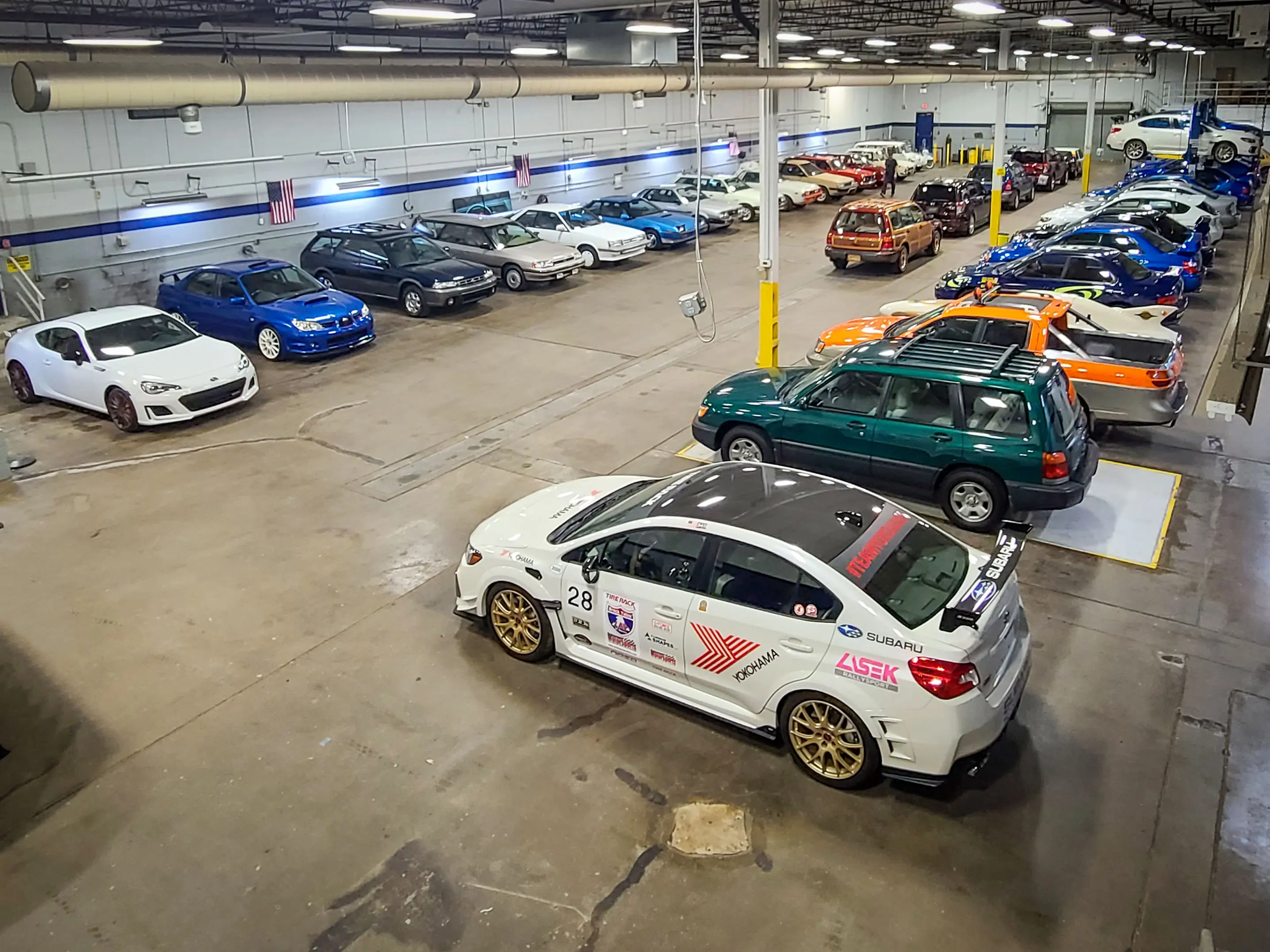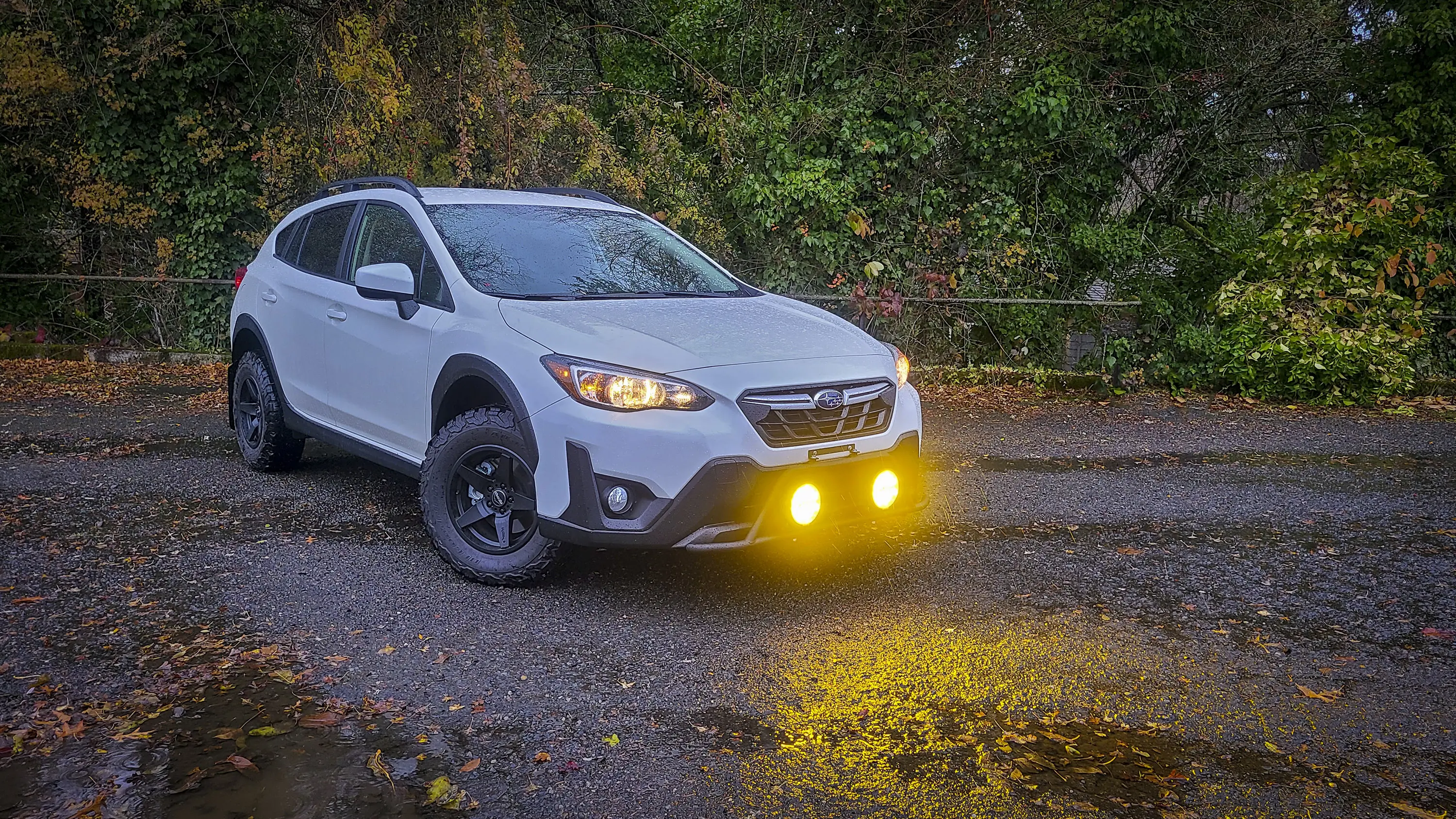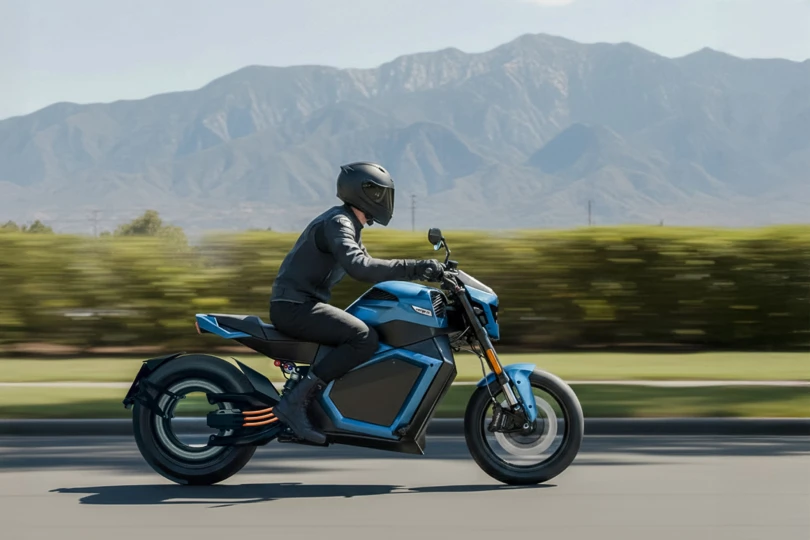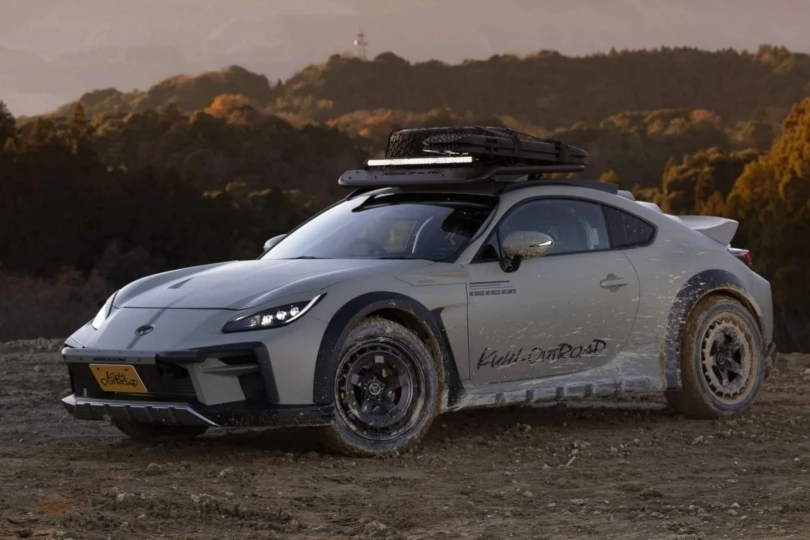This is basically Subaru of America’s “Bat Cave.” Just like Batman’s lair, it’s hidden and full of goodies. It’s a plain building that could be anything — maybe a factory or warehouse. But, inside Subaru’s Bat Cave is a collection of rare and unique cars that isn’t accessible to the public or even most media, but marks the company’s history both here and outside of the U.S.
Subaru’s American history isn’t as well-known as some other manufacturer’s story. But, Subaru of America was originally founded by Harvey Lamm and Malcolm Bricklin in 1968. It operated as a fully independent distributor of Subaru vehicles until 1990, when it became a wholly owned subsidiary of Fuji Heavy Industries, which became Subaru Corporation in 2016. Its private collection is a great way to preserve its history and legacy — and its Legacy sedan and wagon — here in the States.
From the tiny Subaru 360 micro cars to fire-breathing special-edition WRXs, mint-condition Subaru BRATs, oddball one-offs, low-mileage rarities, and concept cars, there’s a little bit of everything — and I got access to it.
What’s Inside: A Secret Stash of Subarus
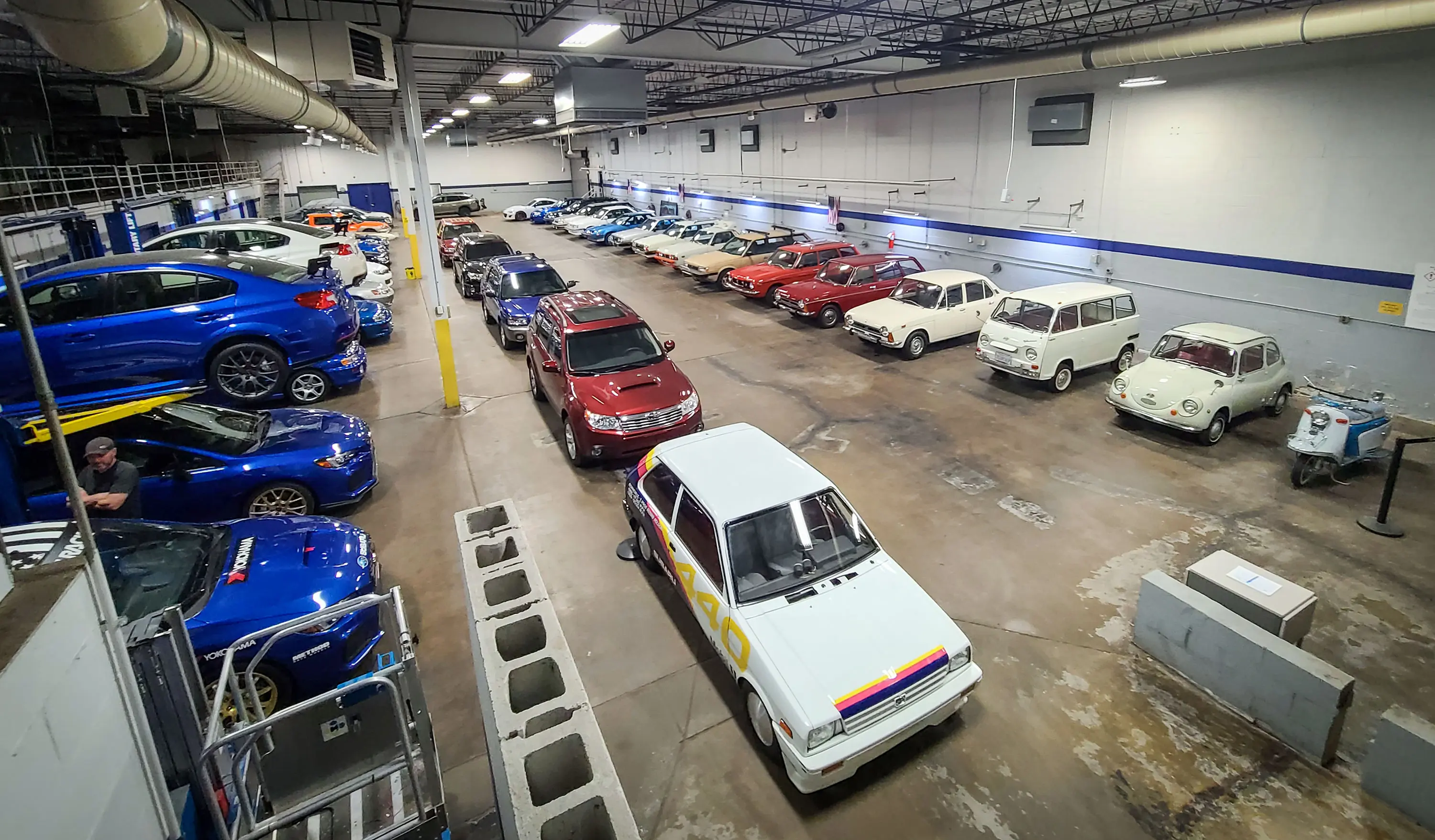
I was told straight away not to disclose the location, but I could take pictures and videos as well as do a story — I agreed.
As you walk into the building, you’re greeted with a well-organized collection of Subaru vehicles ranging from a 1960s Rabbit scooter — the first vehicle sold in the U.S. manufactured by Fuji Heavy Industries, Subaru’s parent company — to the first and last runs of rare WRX models. Oh, and a plethora of concept cars and pristine versions of some of Subaru’s ‘70s and ‘80s vehicles. This is heaven for Subaru enthusiasts such as myself!
There are two-cylinder Subaru 360s, the first BRATs with all of the original factory accessories (yes, the bed-mounted rear-facing seats were there), 1980s Loyales in mint condition, angular and rare 1980s RX and XT cars, 1990s Legacys, and pretty much everything in between. There’s the original Baja concept car — a vehicle ahead of its time — combining AWD and a pickup bed on a car platform.
There are rare JDM (Japanese Domestic Market) Subies, modern rally cars, and vintage race cars. There’s even a 22B — possibly the most desirable Subaru of all time — one of which sold for $312,555 on Bring A Trailer in 2021. There’s even the Subaru FF1 that ran the Baja 1000 in the 1970s.
Subaru of America Collection: The Back Rooms
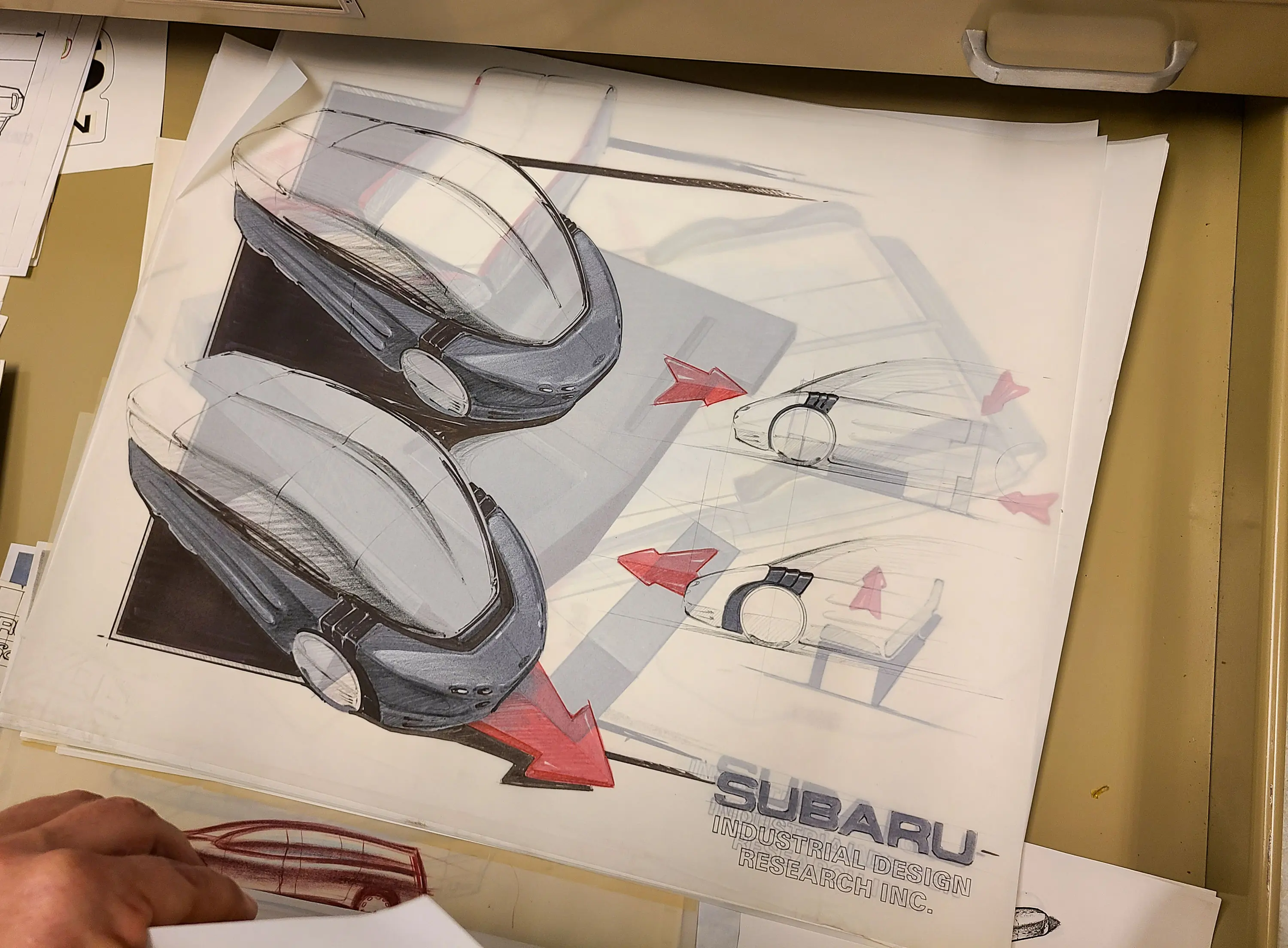
The Subaru team led me into another room filled with Subaru of America’s design sketches, renderings, and various documents. They open a flat-file housing colorful concept sketches done by hand throughout the years. There are line drawings on microfiche and blueprints of accessory ideas that had come from the American design department. This treasure trove made me swoon; I mean, how many people have ever seen this?
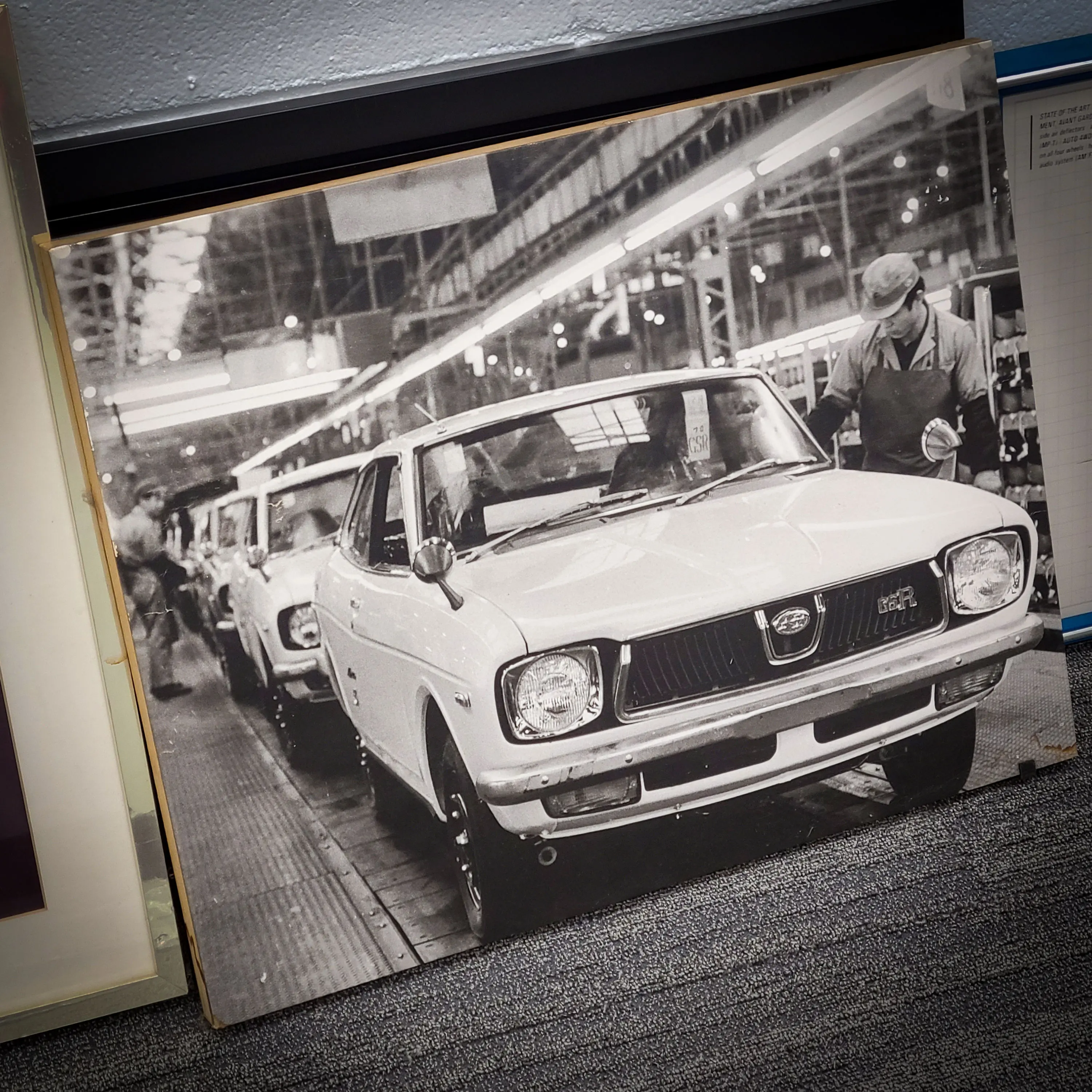



I was told there was yet another backroom that wasn’t quite as well organized, and of course I had to see it. The non-air-conditioned room housed several more vehicles, including a 1970s red-and-white BRAT (the same type President Reagan had), a diesel-powered Subaru Outback, a low-mileage Subaru Justy, magazine project vehicles, and more. Plus, there were scads of parts, cutaways of engines, and old dealership signs and memorabilia.
In total, there are 84 vehicles in this private collection. I’m told employees get to see this area, but most outsiders don’t. I’m exceptionally fortunate to have seen these rare and vintage vehicles along with the plethora of other materials.
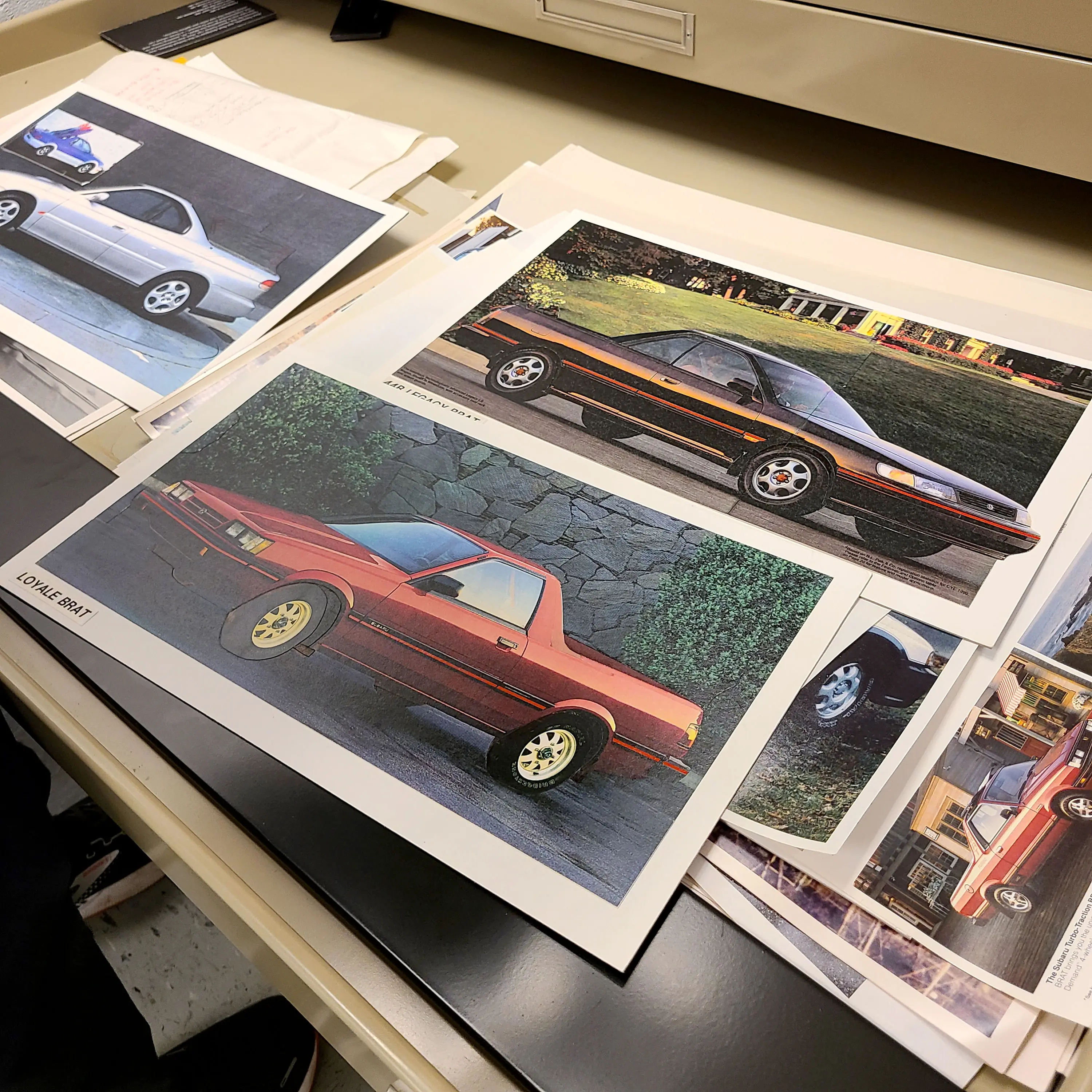



Sharing the Subaru of America Collection Gold
Of course, I took tons of photos and a few notes, so I could share the goods with you here on GearJunkie. Have a gander at some of the gold I found in Subaru’s North American private collection.
1963 Fuji Rabbit Scooter
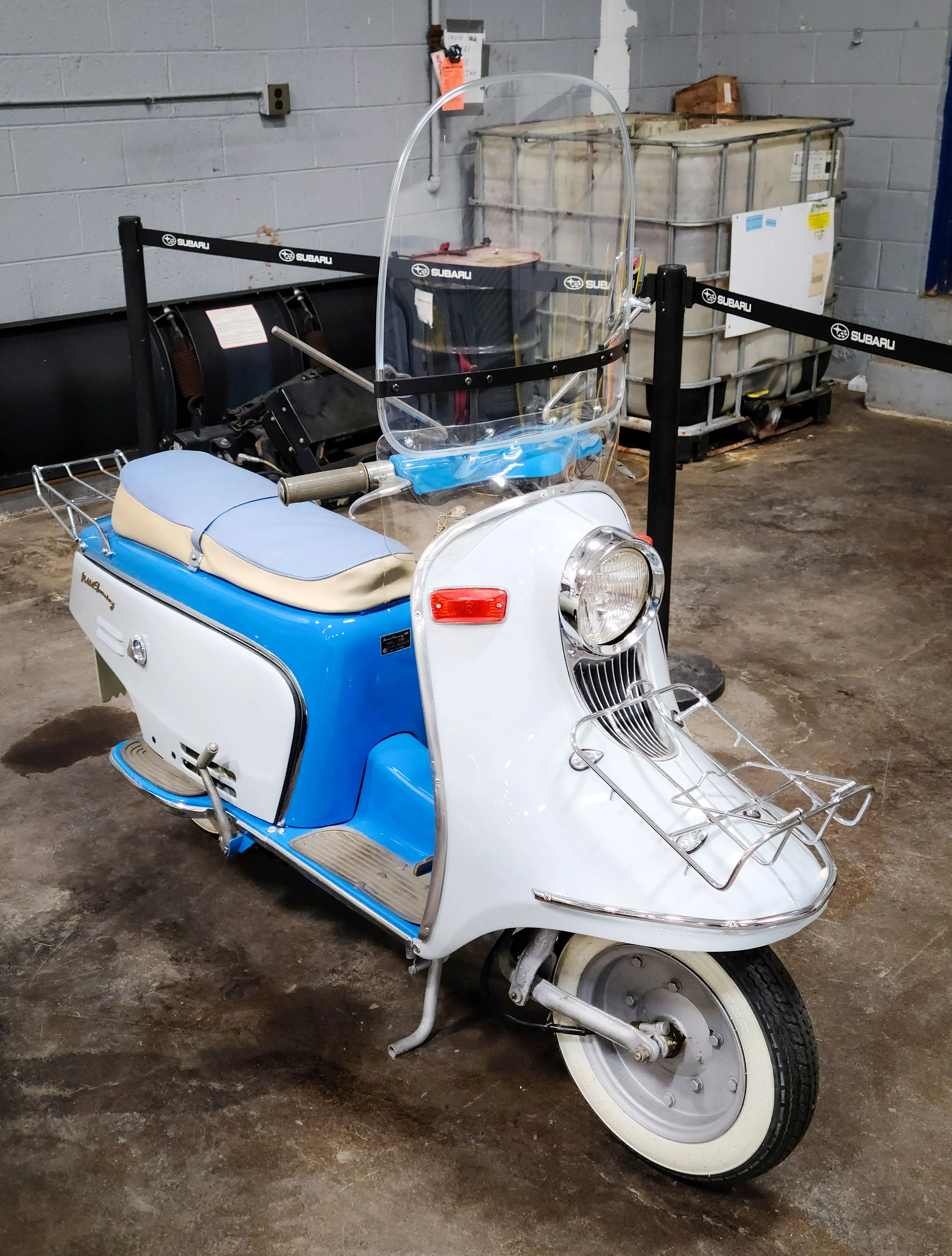



This is the vehicle that started it all for Subaru in North America, the 1963 Fuji Rabbit Scooter. Made by Fuji Heavy Industries, Subaru’s parent company, these two-wheelers were the company’s first entry into the U.S. market.
They were also the vehicle to jumpstart Malcolm Bricklin’s automotive career. While Subaru became a success, one of Bricklin’s other import endeavors, Yugo, wasn’t.
1968 Subaru 360
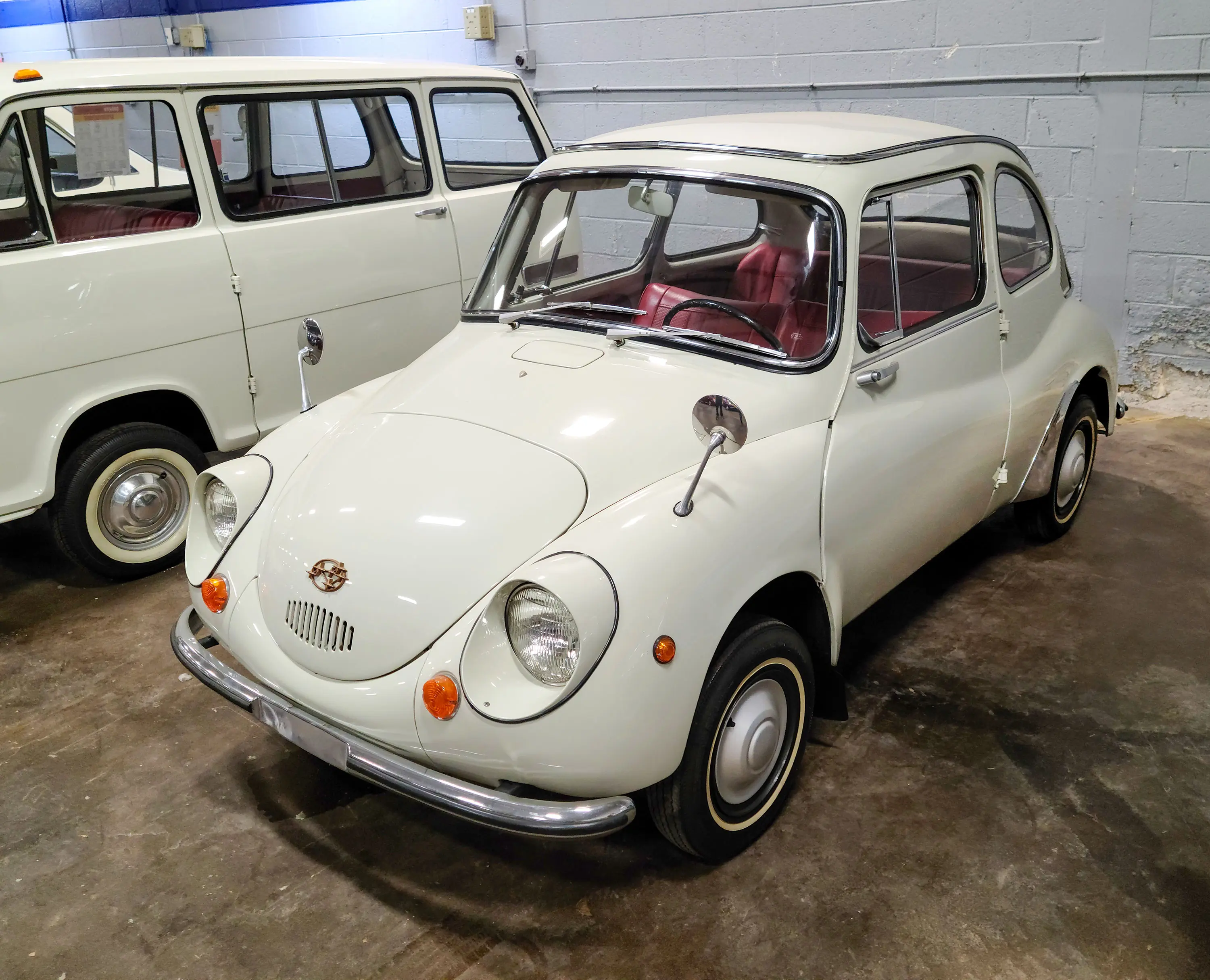



The 1968 Subaru 360 was Subaru’s first four-wheel foray in the U.S. With a small two-cylinder, two-stroke, rear-mounted engine, and sub-1,000 pound curb weight, the 360 was exempt from U.S. safety standards at the time. About 10,000 360 models were imported into the U.S. by Malcolm Bricklin.
1969 Subaru 360 Van
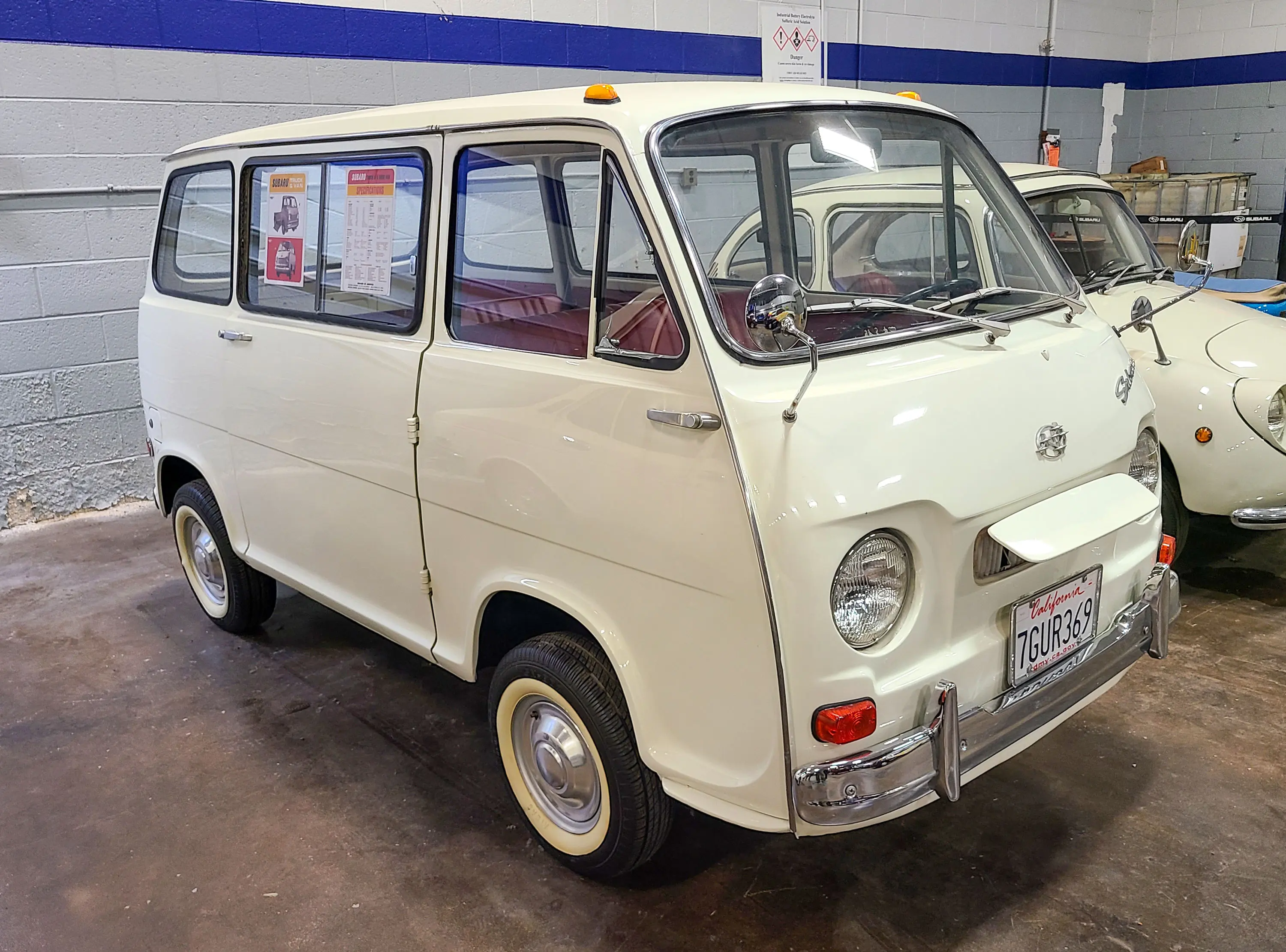



Alongside the petite 360 was the Lilliputian 360 van, also known as the Sambar. This one is a 1969.
These vans had the same rear-mounted 356cc engine and running gear as the coupe, but the more practical and roomy van interior.
Subaru X100
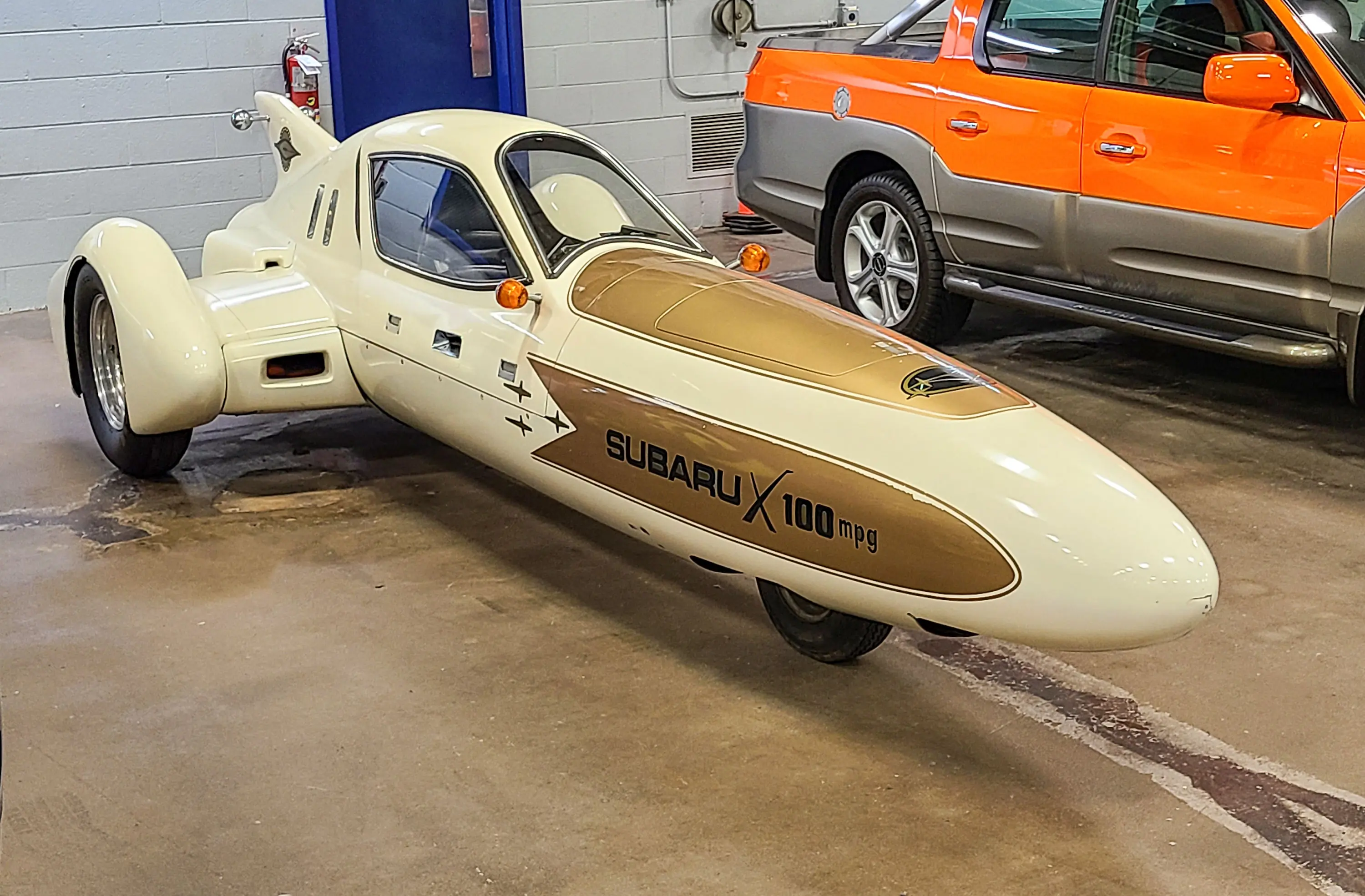



The idea behind the Subaru X-100 was simple: have a vehicle that could cross North America on one tank of fuel. According to Japanese Nostalgic Car, the idea was to fit this three-wheeled contraption with a 25-gallon fuel tank. At 100 mpg, that’d be 2,500 miles, enough to cross the continent.
This would’ve been amazing during the oil embargo of the 1970s. The X-100 took longer than expected to build, and the concept was fitted with a 1-gallon tank for testing, and it was successful. By the time it was said and done, the oil embargo had ended and so had the X-100’s development.
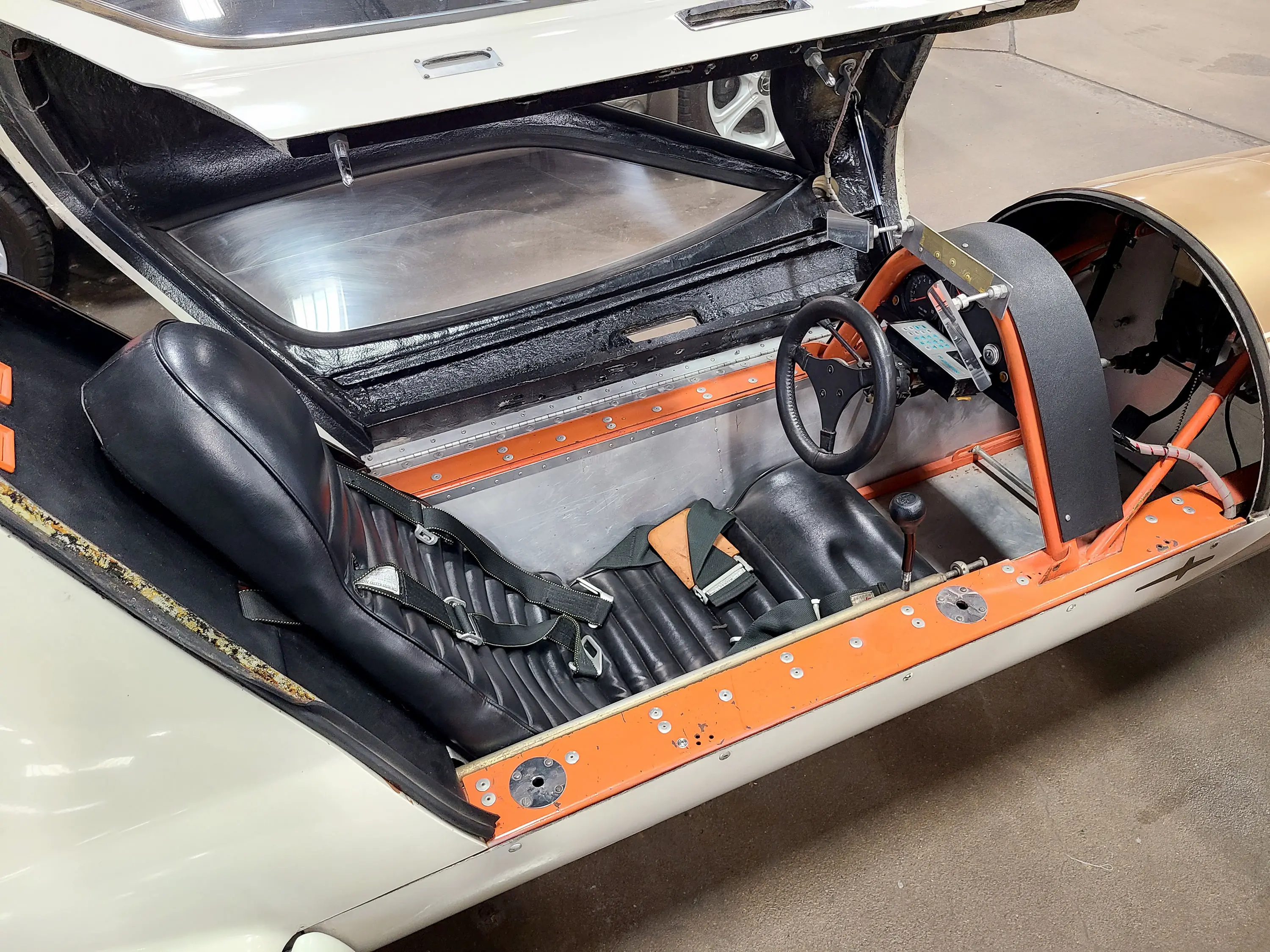



The X-100 was a single-seat vehicle with an airplane-like canopy. It was exceptionally tight. That steering wheel went to a single wheel at the front of the vehicle.
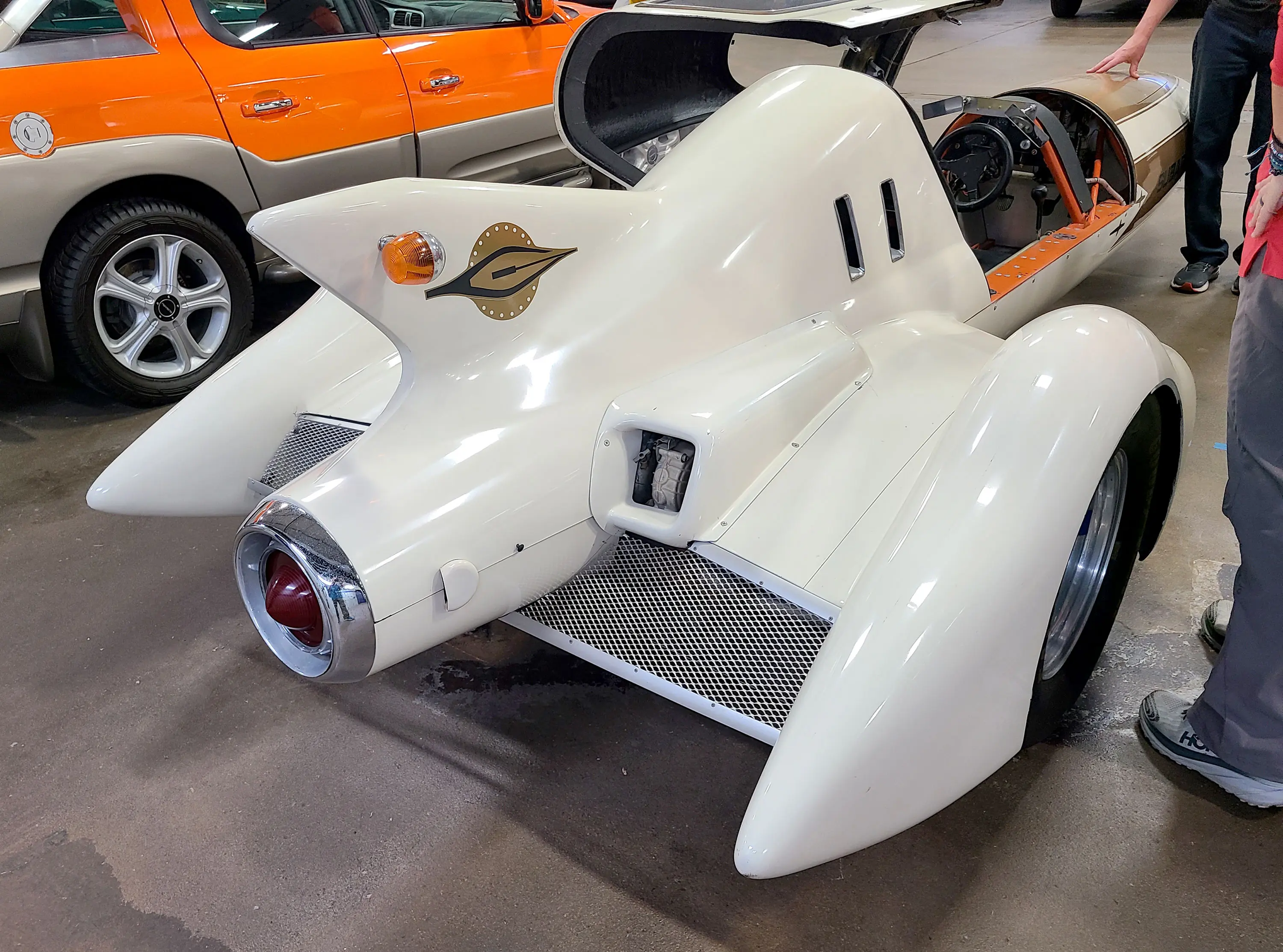



One non-Subaru item? The taillight. This was from a 1955 Ford Thunderbird, of all things.
1978 Subaru BRAT
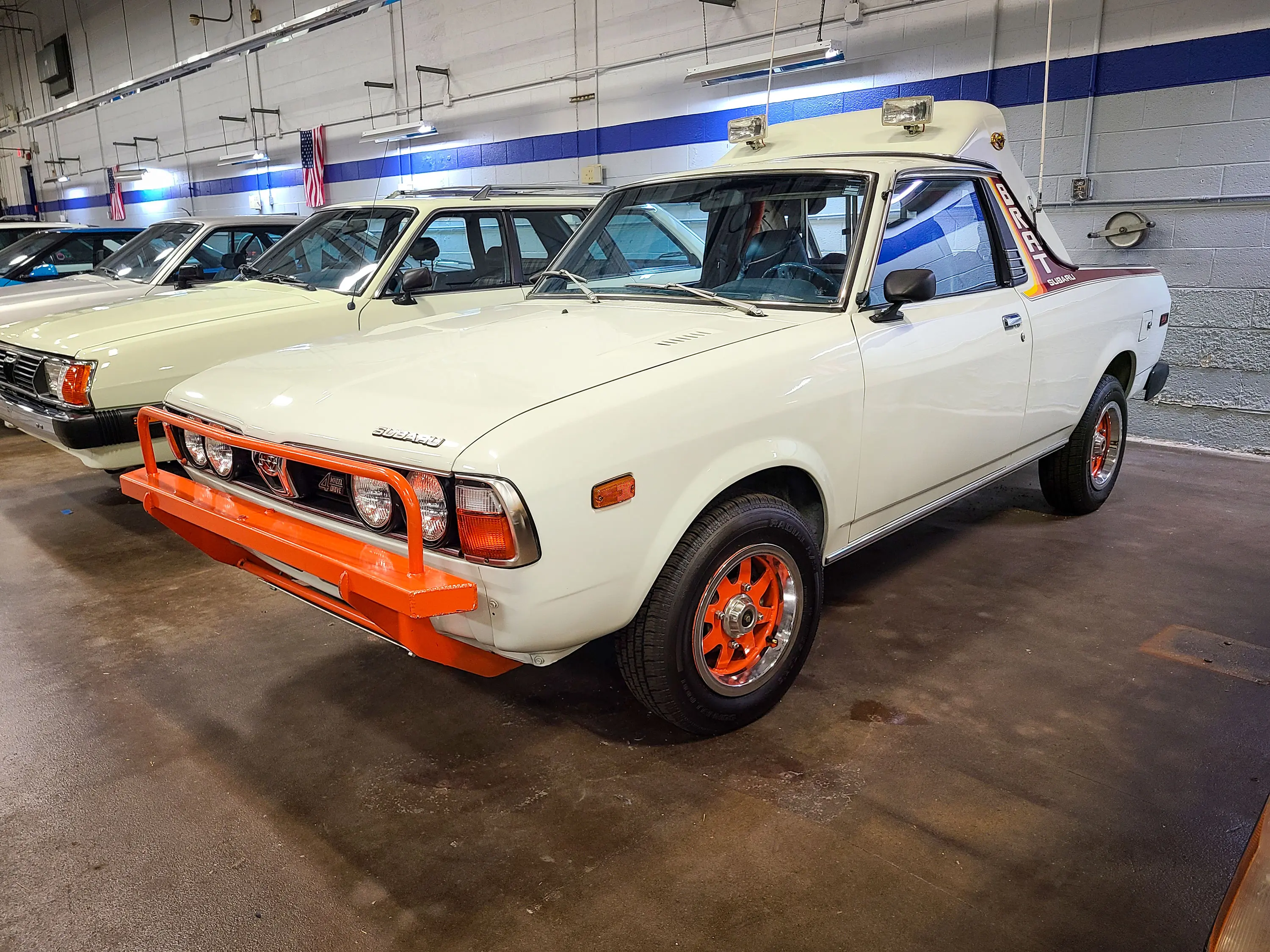



Long before the Baja was in production, Subaru had the BRAT. This stood for Bi-drive Recreational All-terrain Transporter.
This fully accessorized 1978 model — the first BRAT — sports all the add-ons: orange bumper and wheels, racerback bed cowl, extra lights, and of course, the rear-racing bed-mounted seats.
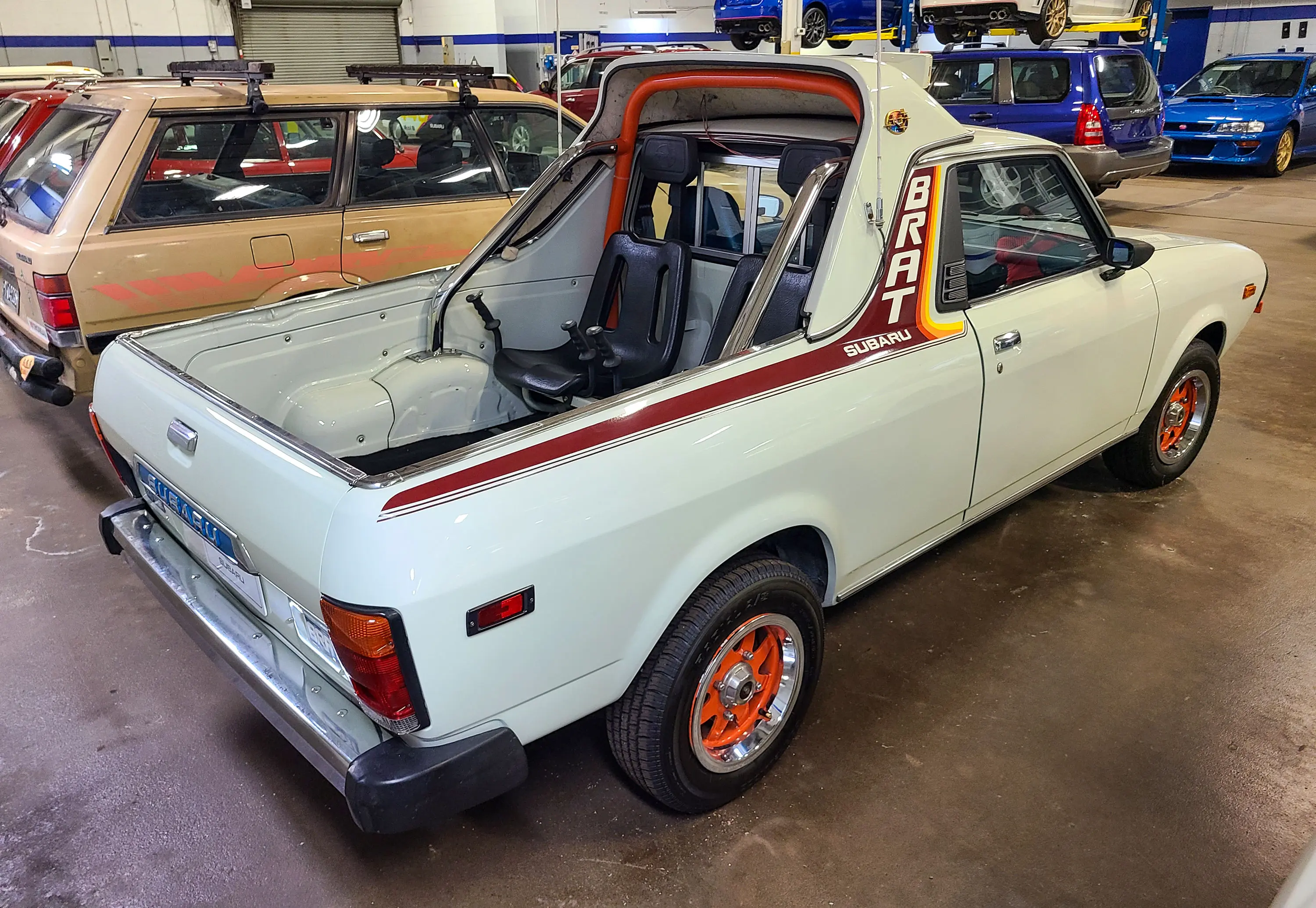



The custom graphics, upper cowl, and painted rollbar helped to show off what a BRAT could look like.
Then there were the infamous rear-racing, rear-mounted plastic seats. Those seats helped Subaru classify the vehicle as a passenger car versus a light truck, thus skirting the infamous 25% “Chicken Tax” on imported light trucks.
2000 Subaru Baja STX Concept
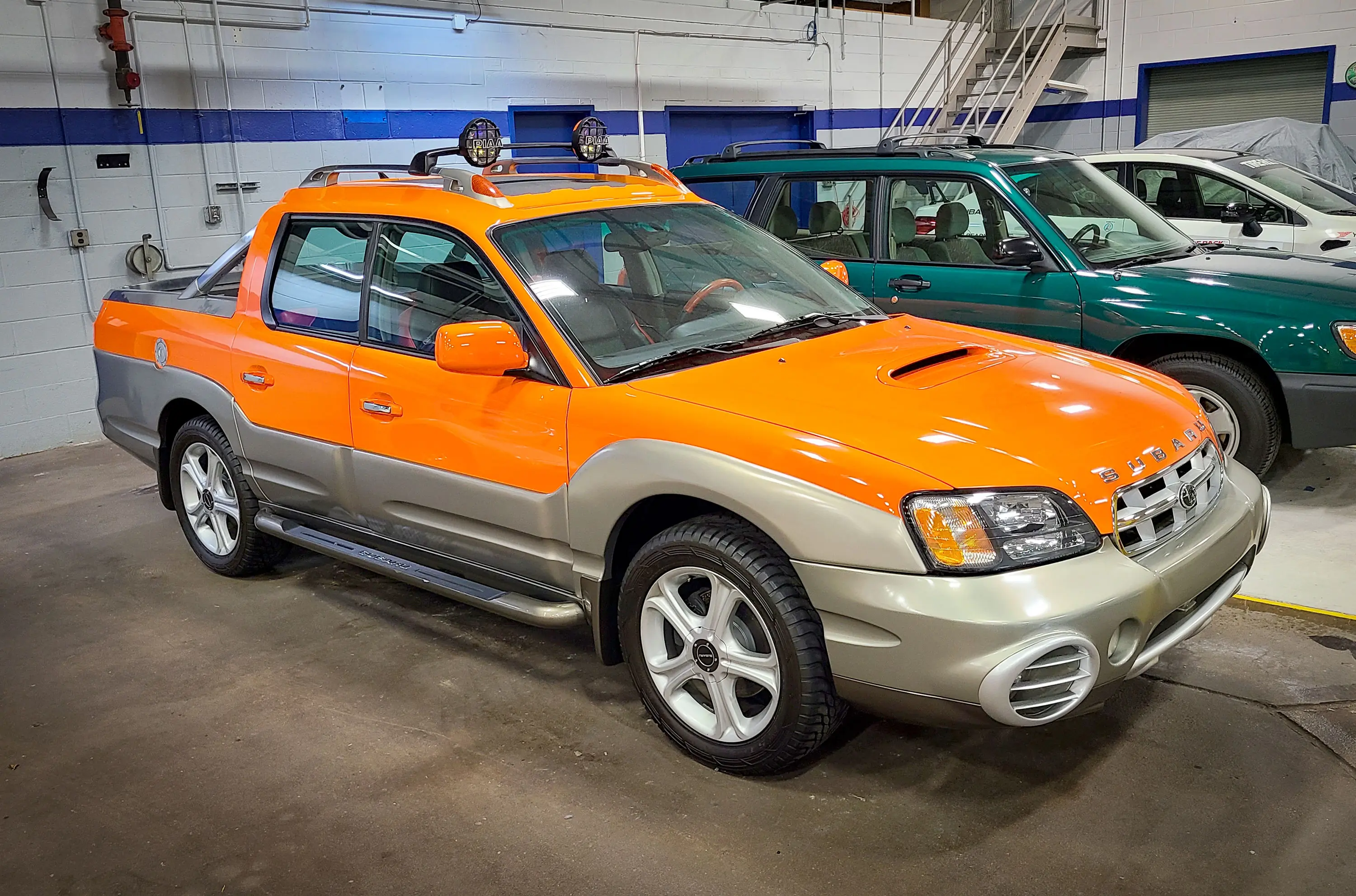



The Subaru Baja STX Concept debuted in model year 2000 at the Los Angeles International Auto Show. Blazingly orange, the concept was essentially a Subaru Outback with a pickup bed versus wagon body.
The Baja went into production in July 2002 but was only produced until 2006. It was clearly ahead of its time, as we now have the Ford Maverick, Honda Ridgeline, and Hyundai Santa Cruz cashing in on this recipe.
1974 Subaru DL Wagon
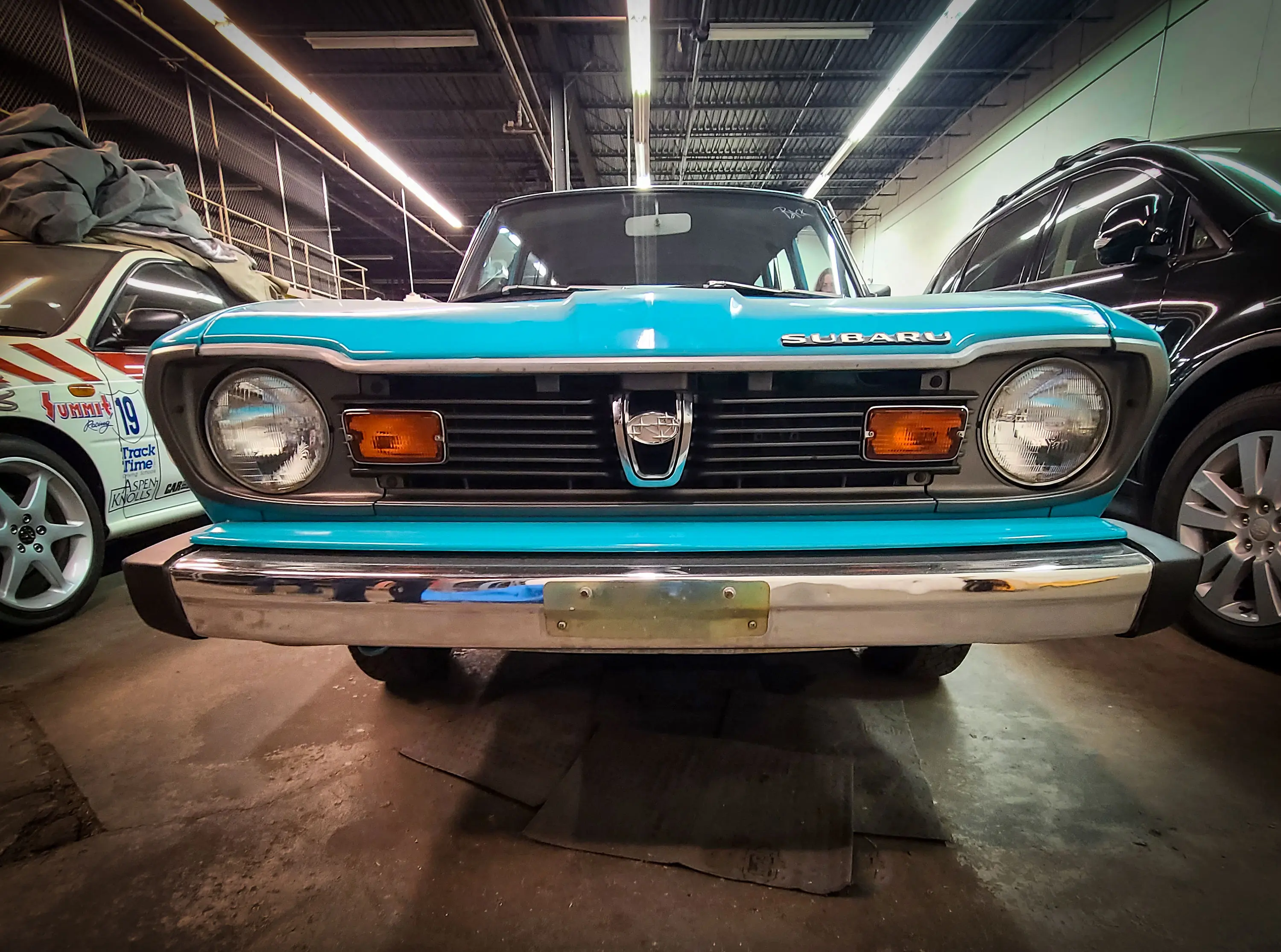



This bright blue 2WD 1974 Subaru DL Wagon was one of the many vehicles in Subaru’s back room. We were able to get up close and personal with many of them.
1976 Subaru DL 4×4 Wagon
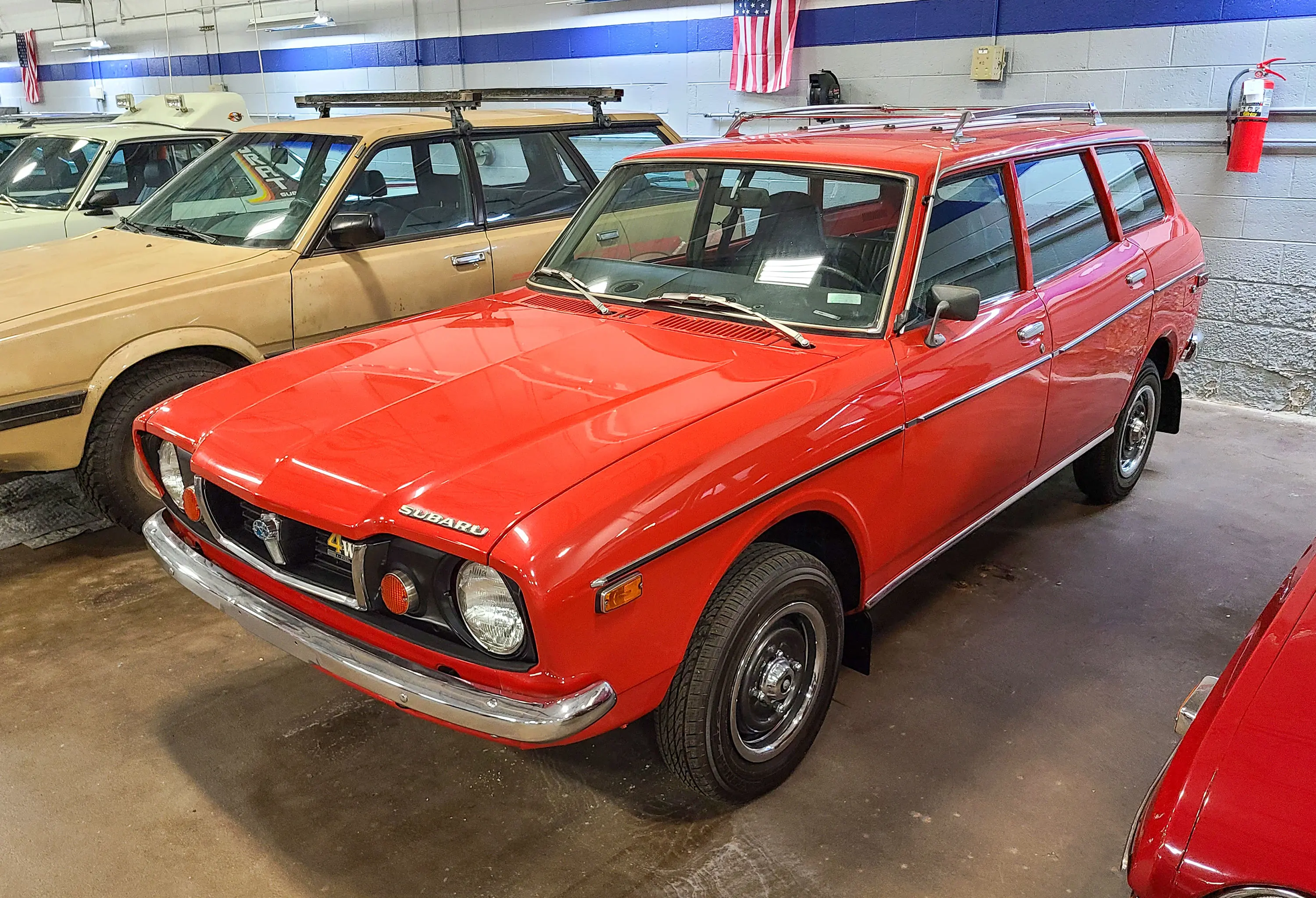



The Subaru Leone DL (or just DL) was available in coupe, sedan, and wagon form. This bright red 1976 wagon in excellent condition represented a 4WD model with a 1.6L horizontally opposed “boxer” engine. This was also the company’s first 4WD wagon.
1971 Subaru FF-1
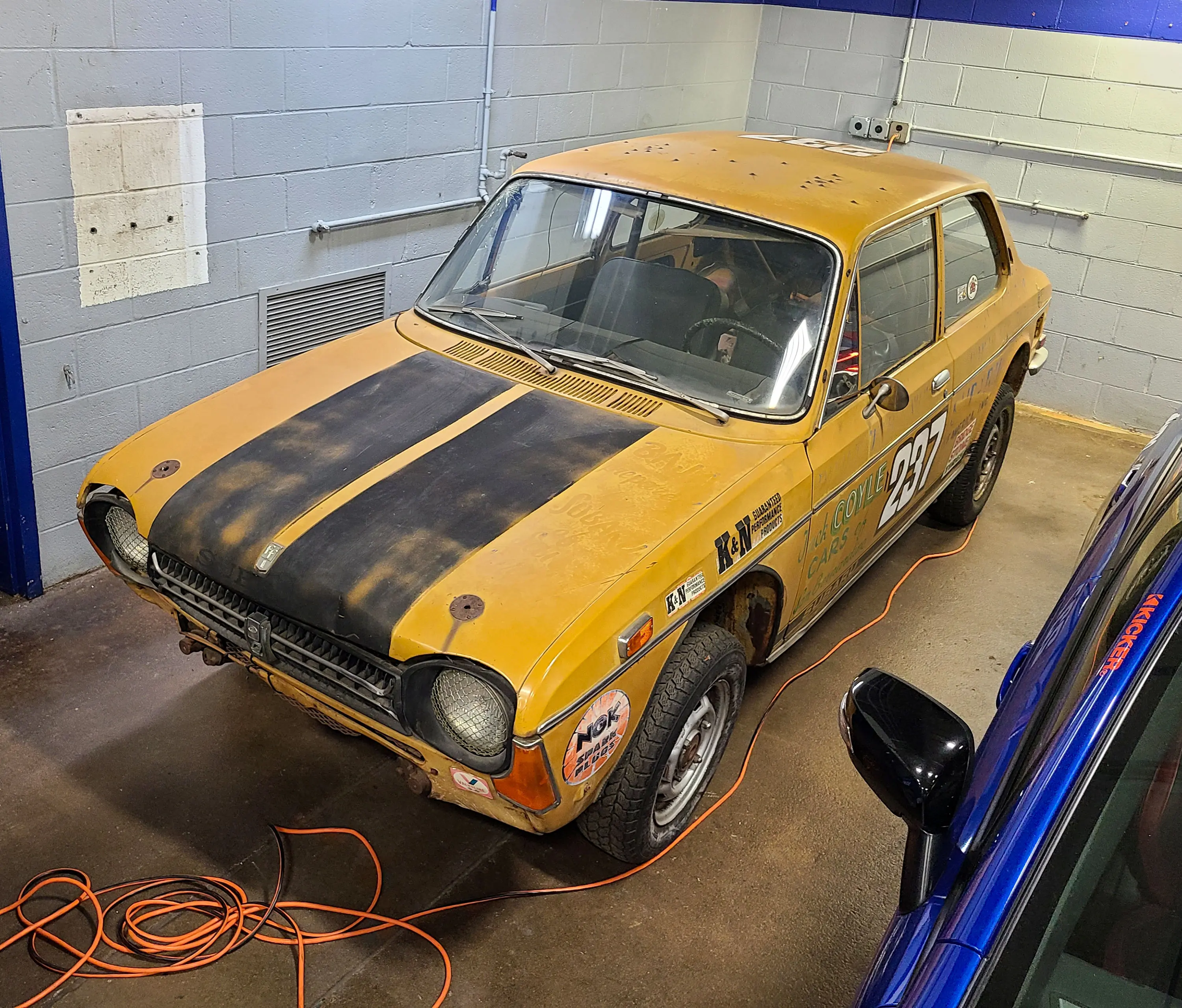



Parked in a corner of Subaru’s collection is this disheveled 1971 FF-1. The FF-1 was Japan’s first front-drive car with a horizontally opposed boxer engine.
This one in particular is special: it competed in the 1971, 1972, and 1973 Baja 1000. The car was privately campaigned and is said to be one of the inspirations for the company’s rally heritage and famous STi (Subaru Technica International) tuning division.
1981 Subaru GL Wagon
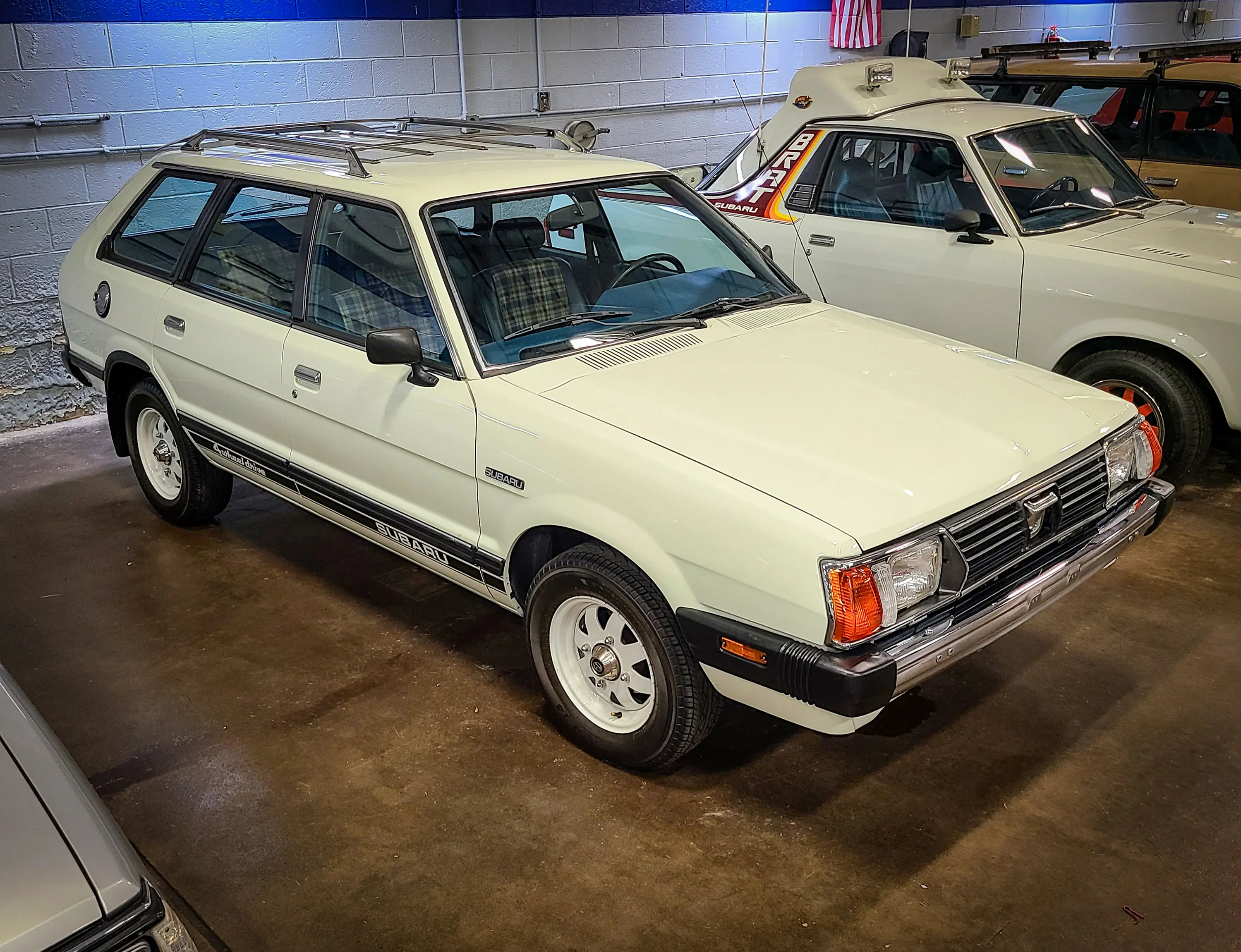



While Subaru’s first 4WD wagon was the DL, the GL was its successor. Certain models had an optional third headlight in the car’s grille. This light had a vacuum-actuated lid that’d open up when the lights were turned on.
It could be argued that the GL was the first mainstream Subaru wagon. This particular model is a 1981, but wagons of this style were offered until 1984 in the U.S.
1998 Subaru Impreza 22B STi
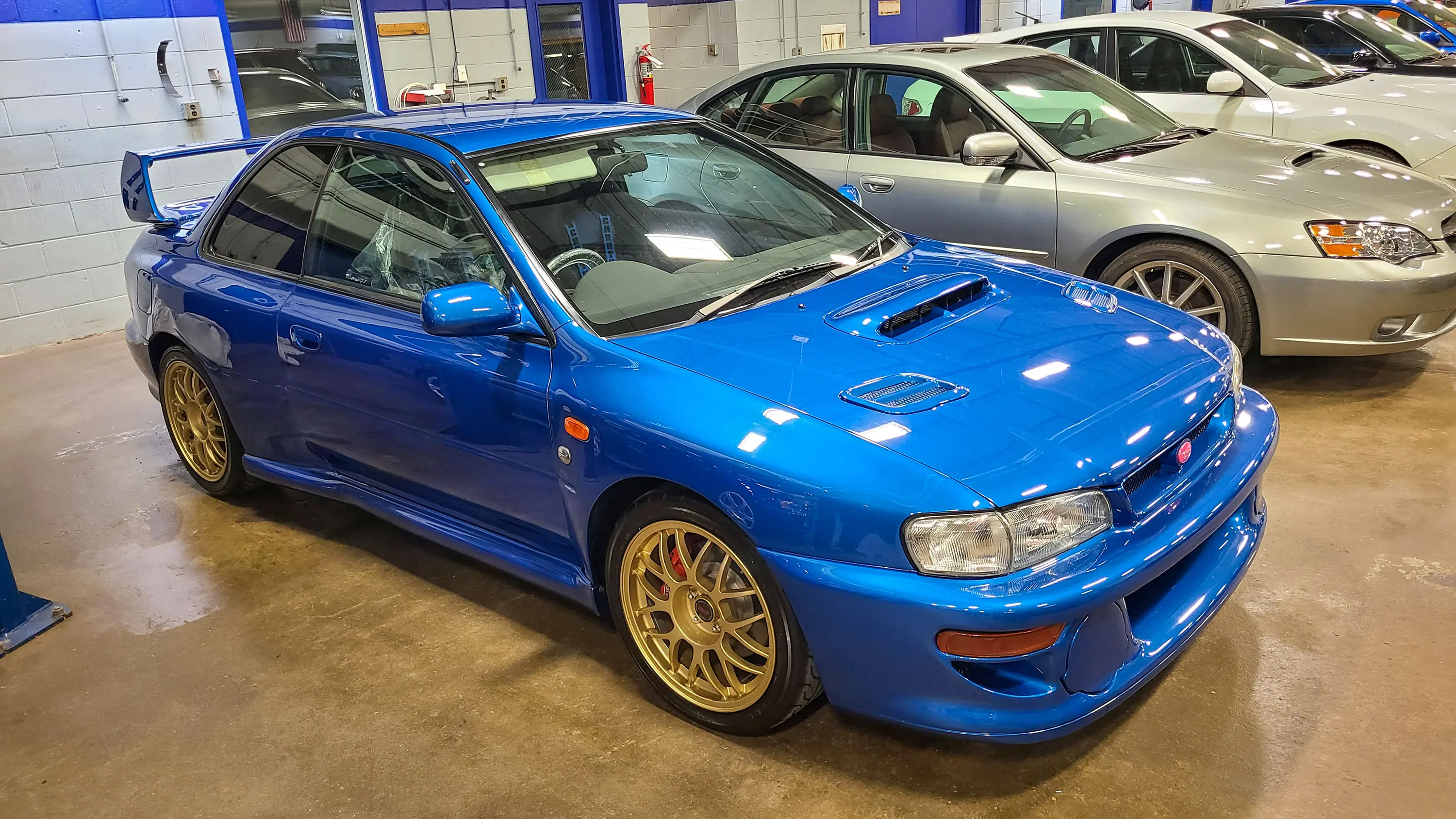



This may be the most desirable Subaru ever made: the JDM 1998 Impreza WRX 22B STi. With fat fenders, a big spoiler, and all the go-fast goodies, the 22B was created as an homage to performance, a celebration of three consecutive titles in the WRC rally series, and the company’s 40th year in business.
Only 424 of them were produced globally. These have been sold for over $300,000 at auction, making them one of the rarest and most valuable Subarus on the planet.
Officially, the cars made 280 horsepower, but that’s been called into question as Japan had a long agreement not to make vehicles with over 280 horsepower — wink, wink.
Amazingly, we were told this 22B was a U.S. press fleet car at one point. Little did they know this right-hand-drive car would ever be worth over a quarter-million dollars!
1996 Impreza WRX #555 (JDM)
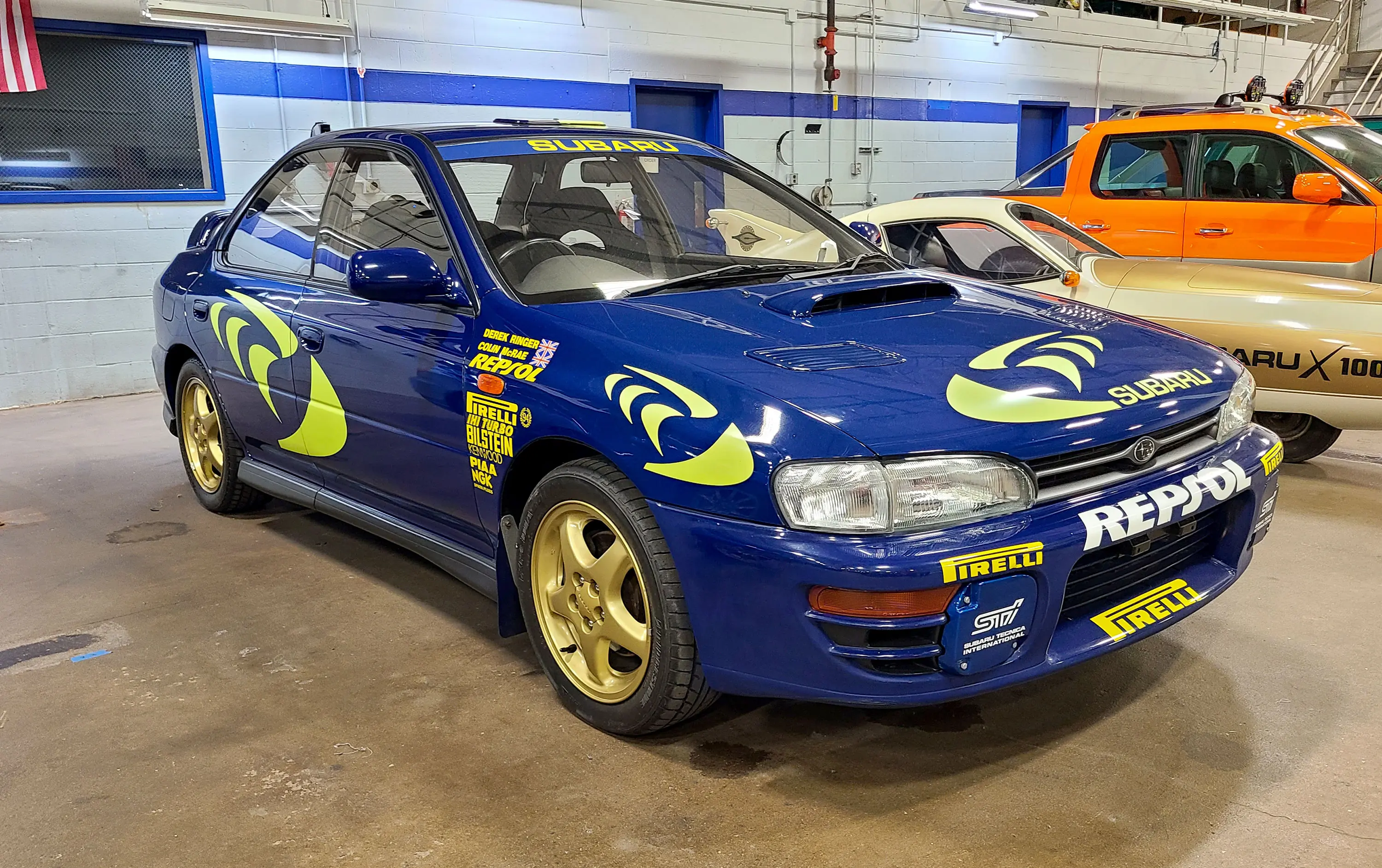



This is JDM 1996 Impreza WRX #555 with a rare factory graphics package designed to replicate the late Collin McRae’s rally car. While it looks like a full-on race-ready car, it’s just a graphics package. The stylized logo replaced the numbers 555, which were the State Express 555 cigarette company logo.
1993 Subaru Justy 4WD
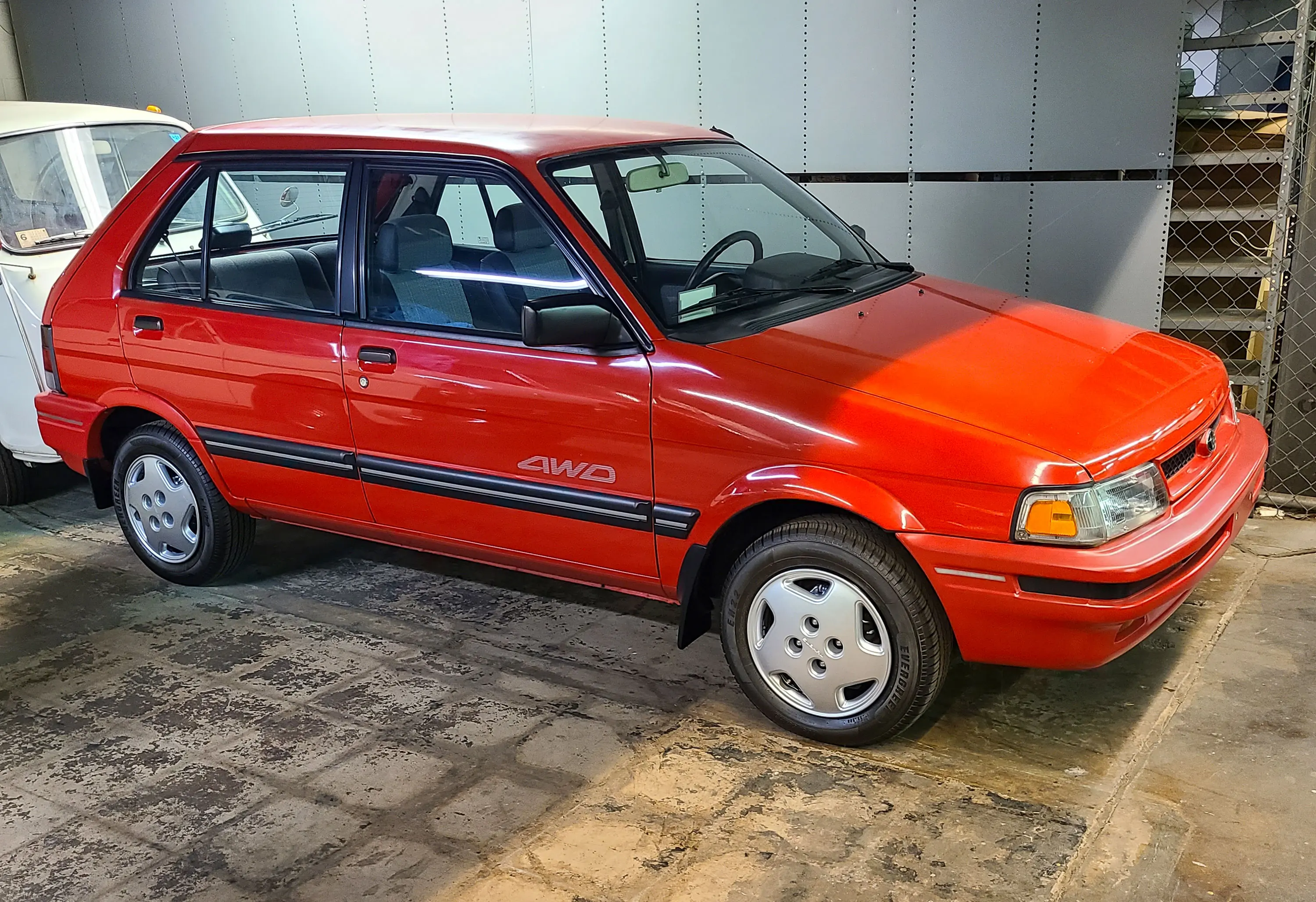



The Subaru Justy was the company’s subcompact car in the 1980s-990s. The tiny Justy models for North America were offered from 1984 to 1994 in two- or four-wheel drive; this model is a 1993.
They were notable for a couple of things, one of which being the first car sold in North America with a CVT, the other being one of the last cars sold with a carburetor (1990). They were also one of few cars offering a three-cylinder engine (1.2 L), and probably the only three-banger with 4WD in North America, too.
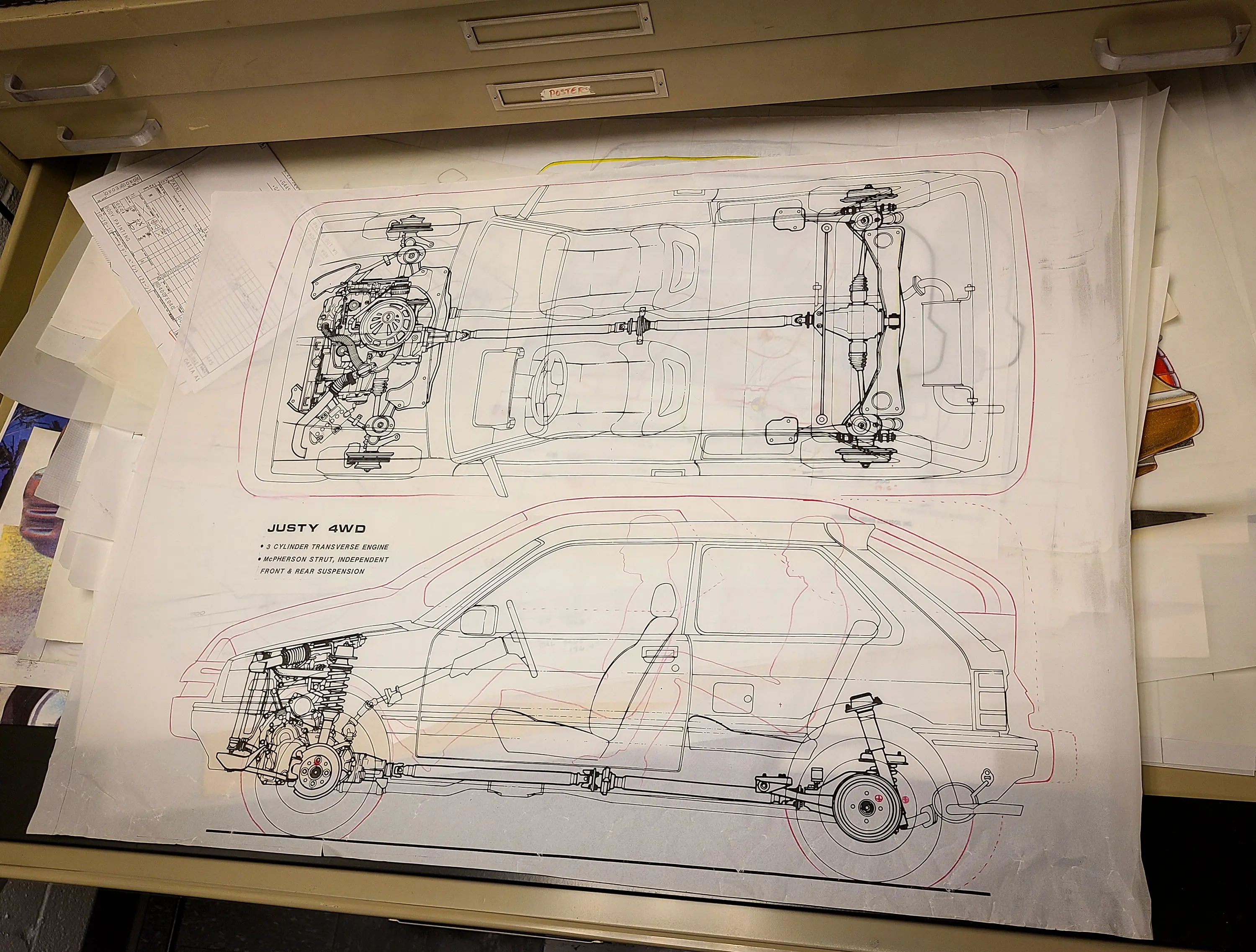



Another treasure in the company’s flat file was this cutaway line drawing of the 4WD Justy. You can clearly see the subcompact car’s engine and driveline layout.
1987 Subaru RX
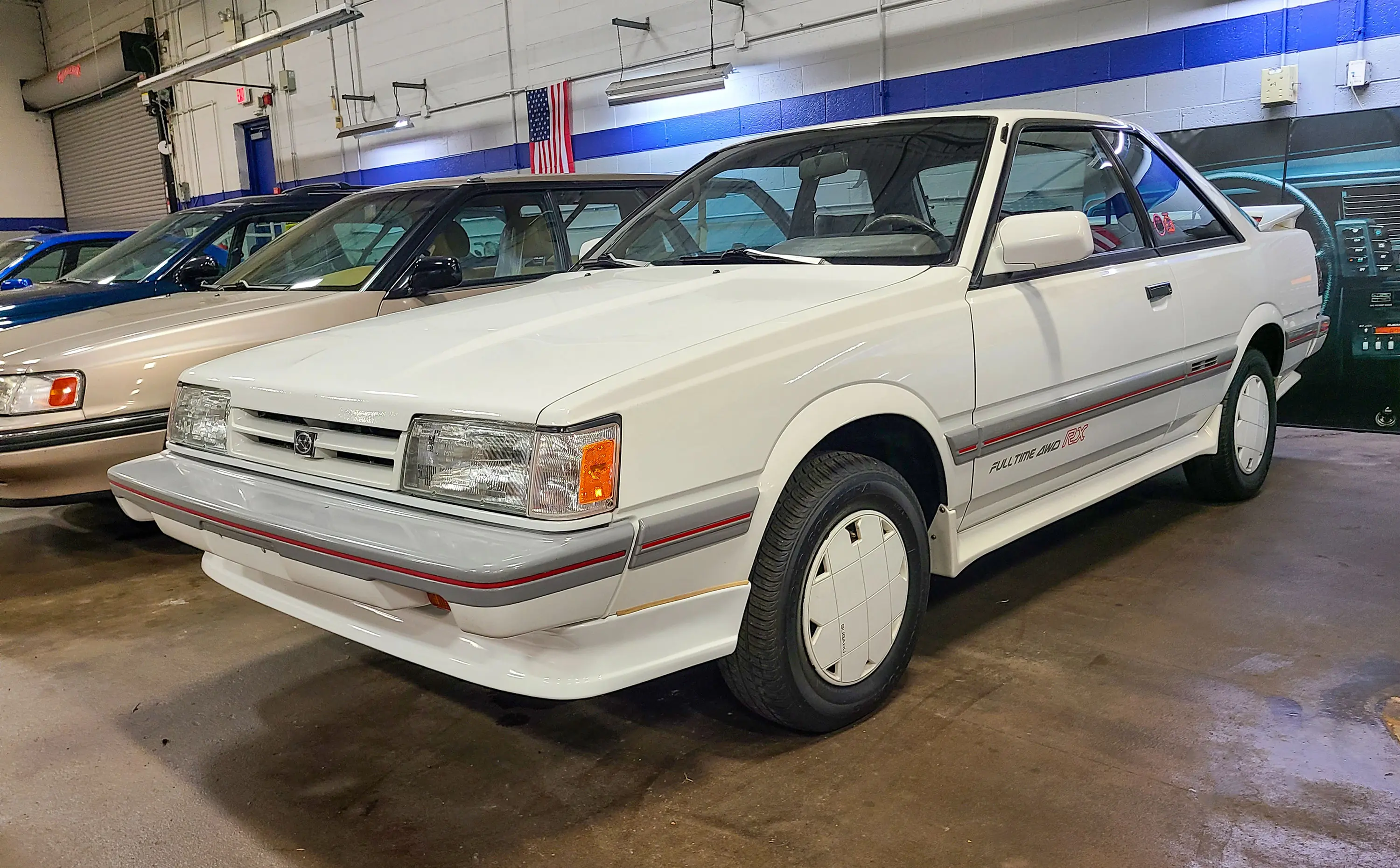



Before the legendary WRX, there was the RX. Introduced in 1987, the RX had 4WD and a turbocharged 1.8L EA82T engine making 115 horsepower and 134 pound-feet of torque.
These buggers even had a low-range transfer case for off-road action. Only 2,600 of these were imported to North America, making them a true rarity.
1986 Subaru XT
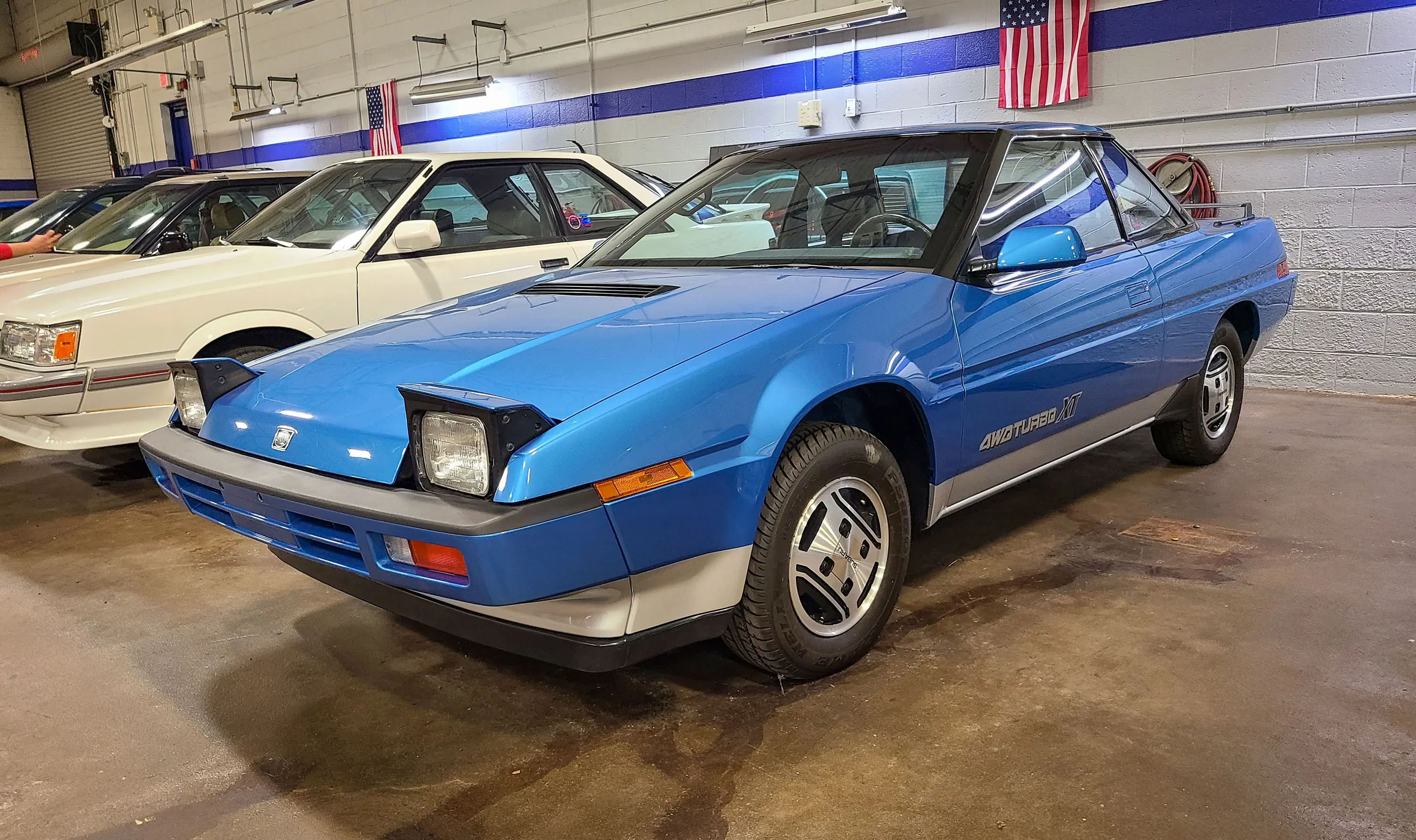



This Subaru XT GL 10 epitomized 1980s futuristic styling. With an angular shape, 4WD, and a turbocharged 1.8L engine (and, of course, a digital dashboard), the future was now … in 1986.
The XT was in production from 1985 until 1991 when it was replaced by the equally funky SVX. This ’86 XT GL 10 show vehicle was in perfect shape and was the only vehicle in the collection with pop-up headlights. Ah, the ’80s.
Subaru Justy LSR




Did you know a Subaru vehicle holds a land-speed record? Did you know it was … a Justy?
This little car took the I/Production record in 1988 at 117.553 mpg and bested itself in 1989 going 123.224 mph! This is a record that still stands today!
The car still utilized the 1.0L three-banger engine, but had select modifications to make it faster than any Justy ever.
1982 Subaru BRAT With Custom Camper
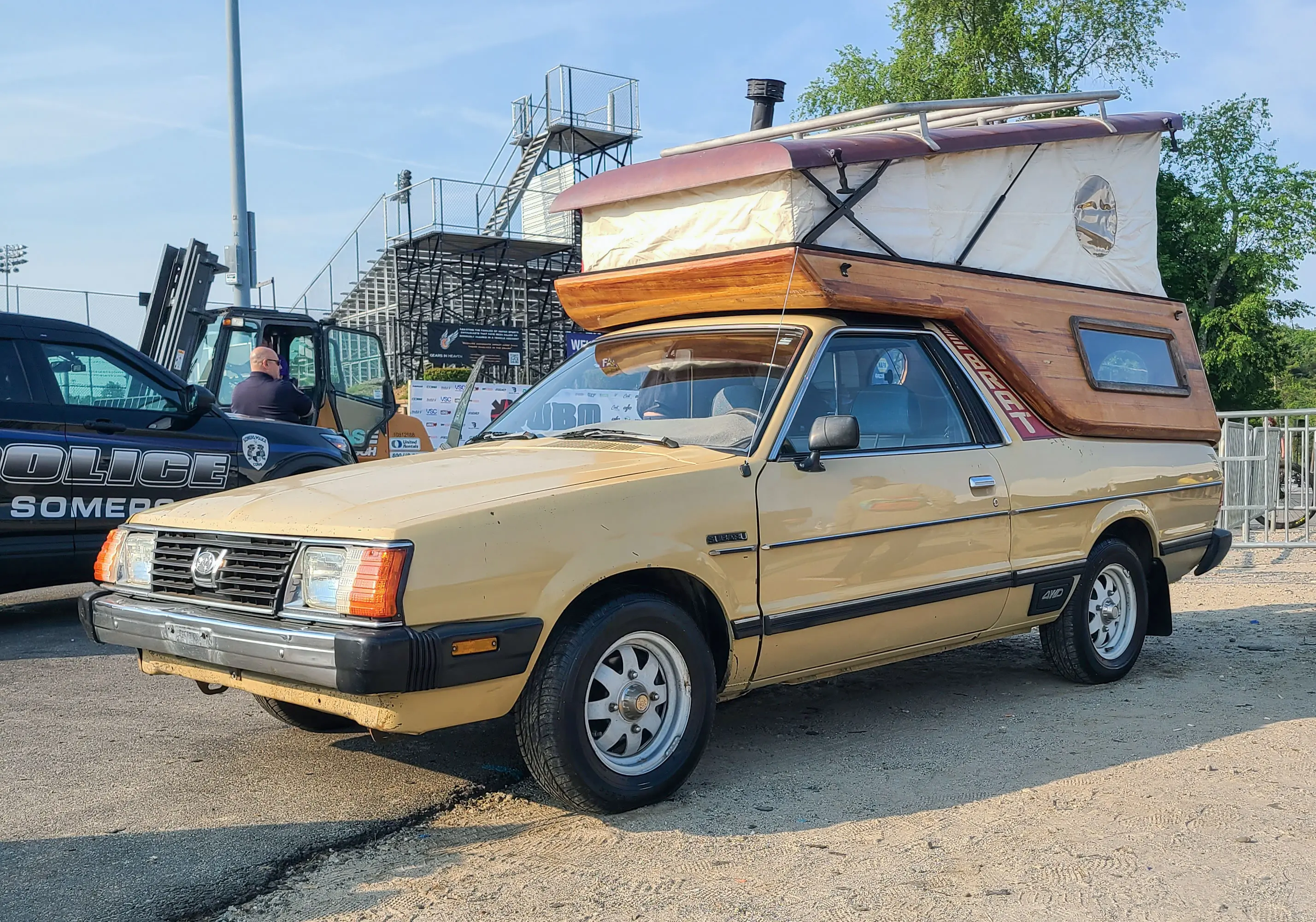



This is a 1982 Subaru BRAT with a completely custom camper on the rear. The car is part of the company’s collection but is currently on tour for the Subiefest shows, which are sponsored by Subaru.
The camper, made by artist Jay Nelson, pops up for compact camping abilities, complete with a wood stove.
1992 Subaru SVX Indy Pace Car
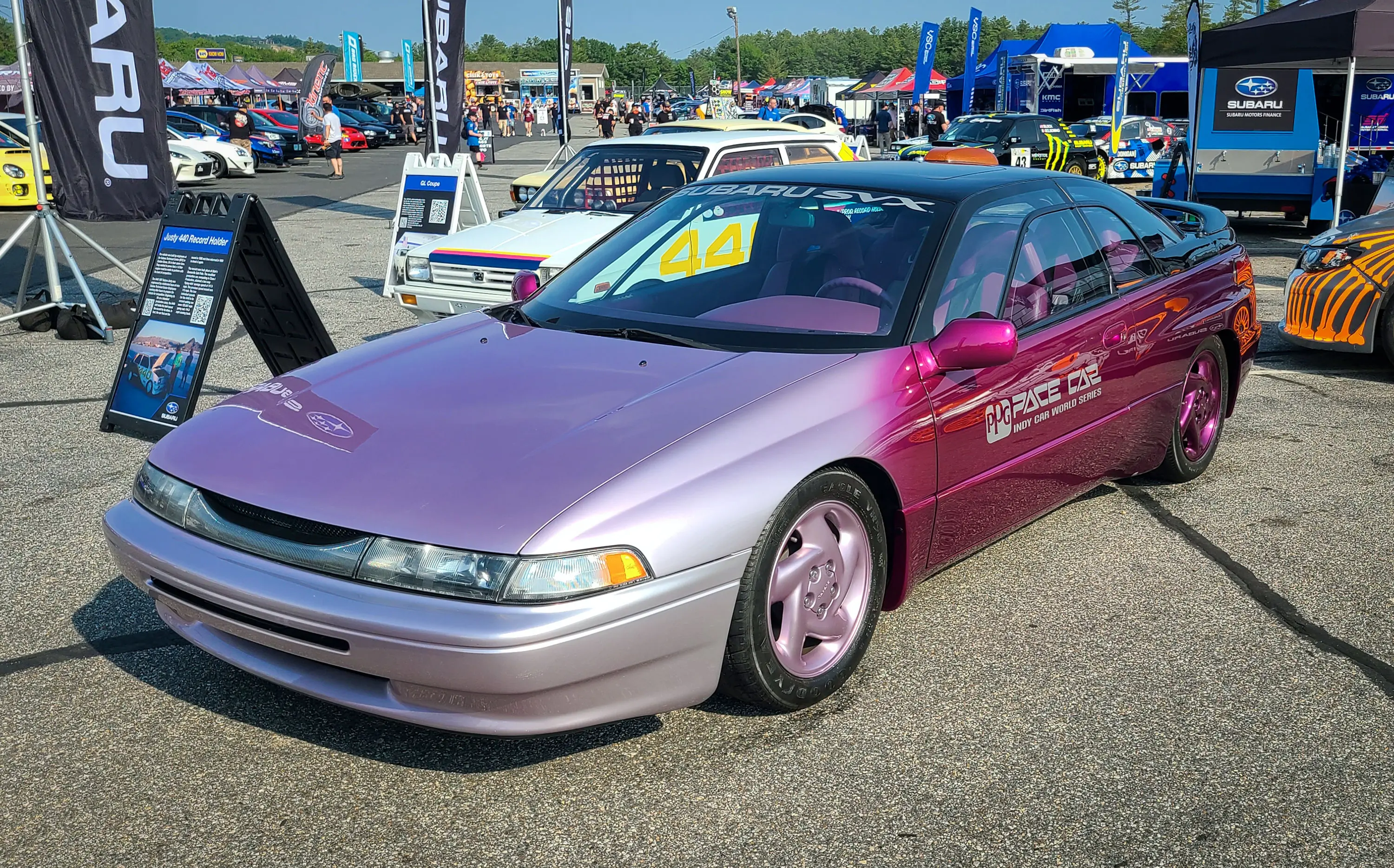



Another car from the private collection currently on tour with Subifest is this rad 1992 Subaru SVX. Coated in a PPG pink paint fade, the groundbreaking SVX, with its operable windows set inside other windows, was used as a pace car at the Indy Car World Series for several seasons in the 1990s.
